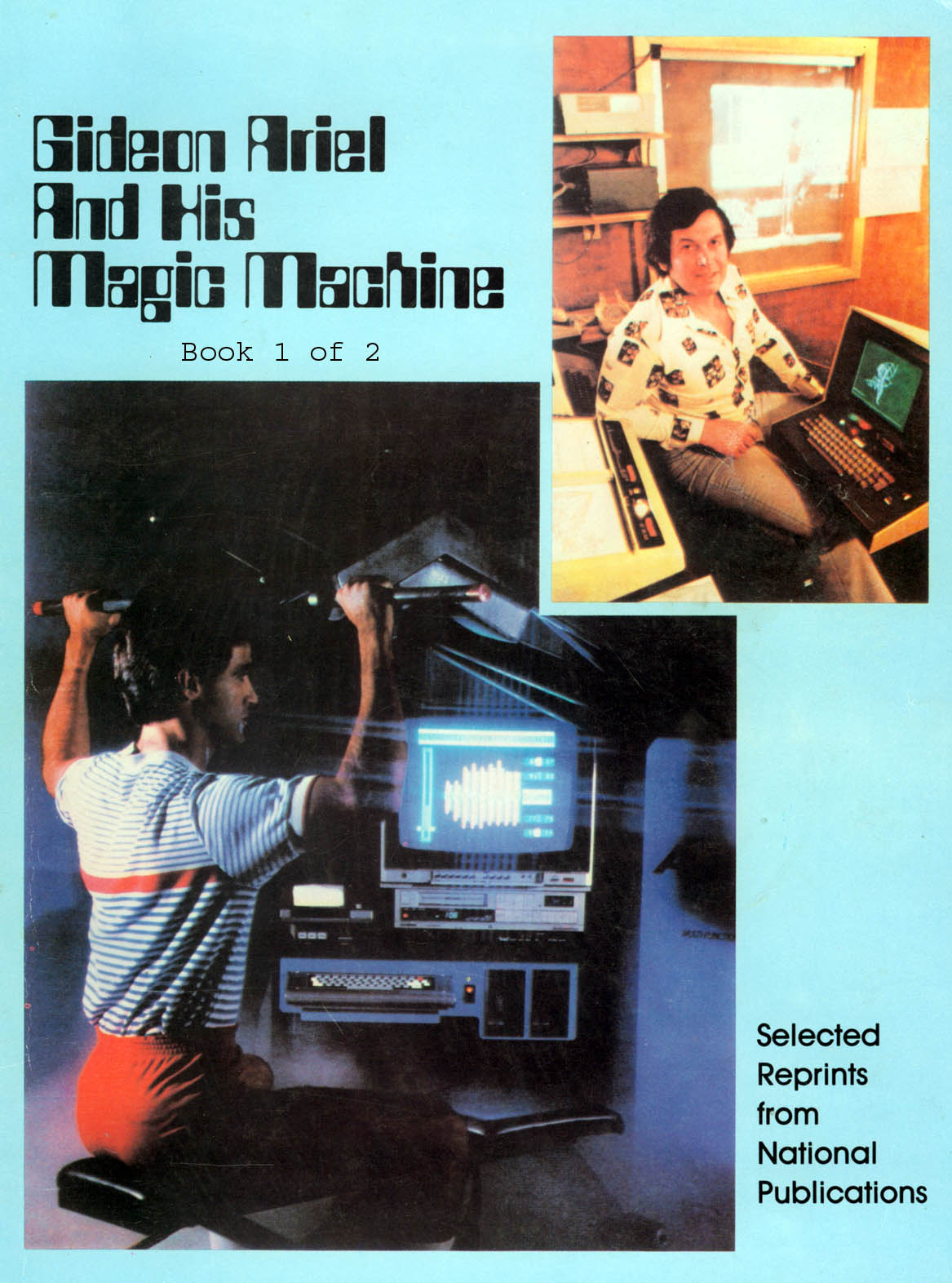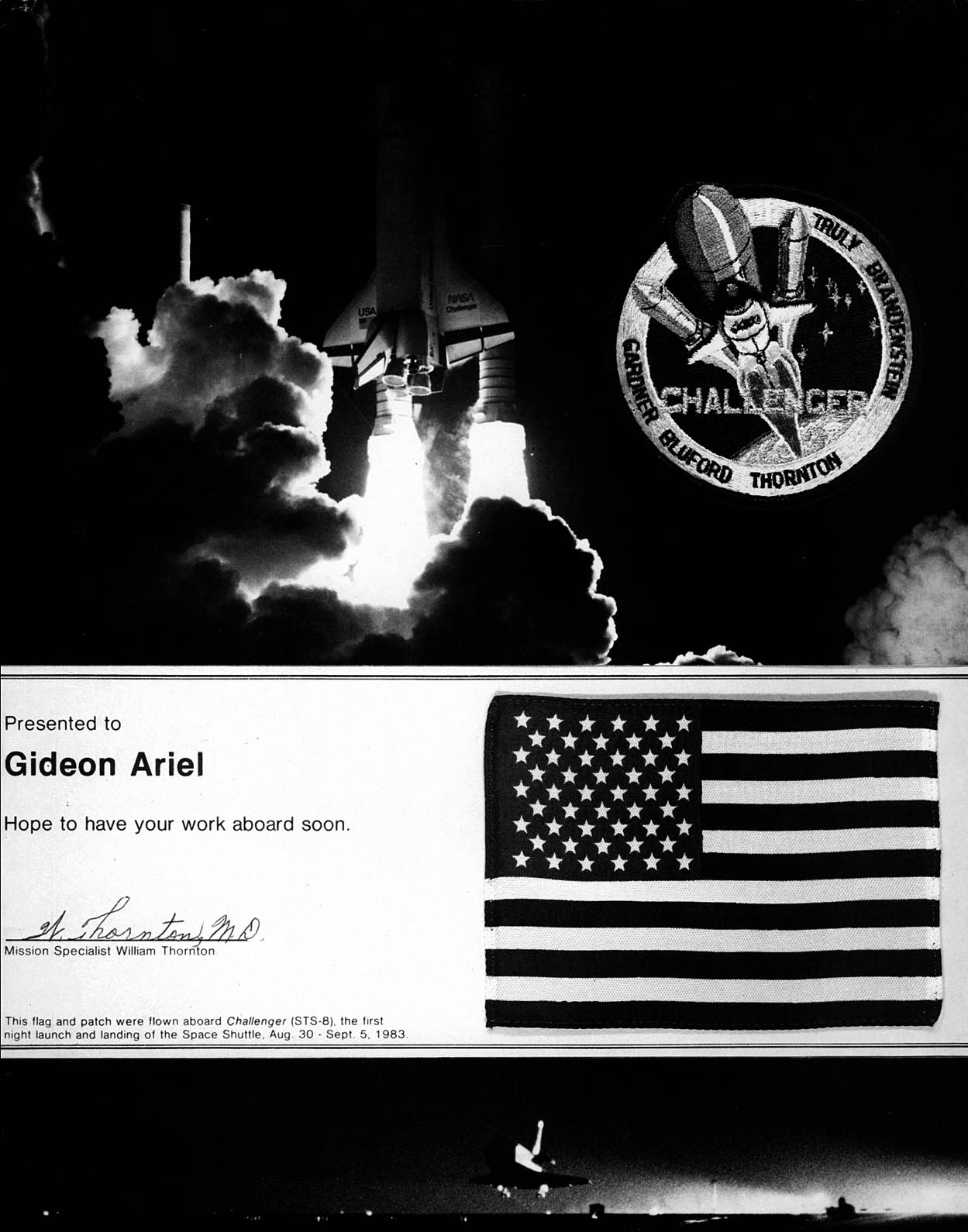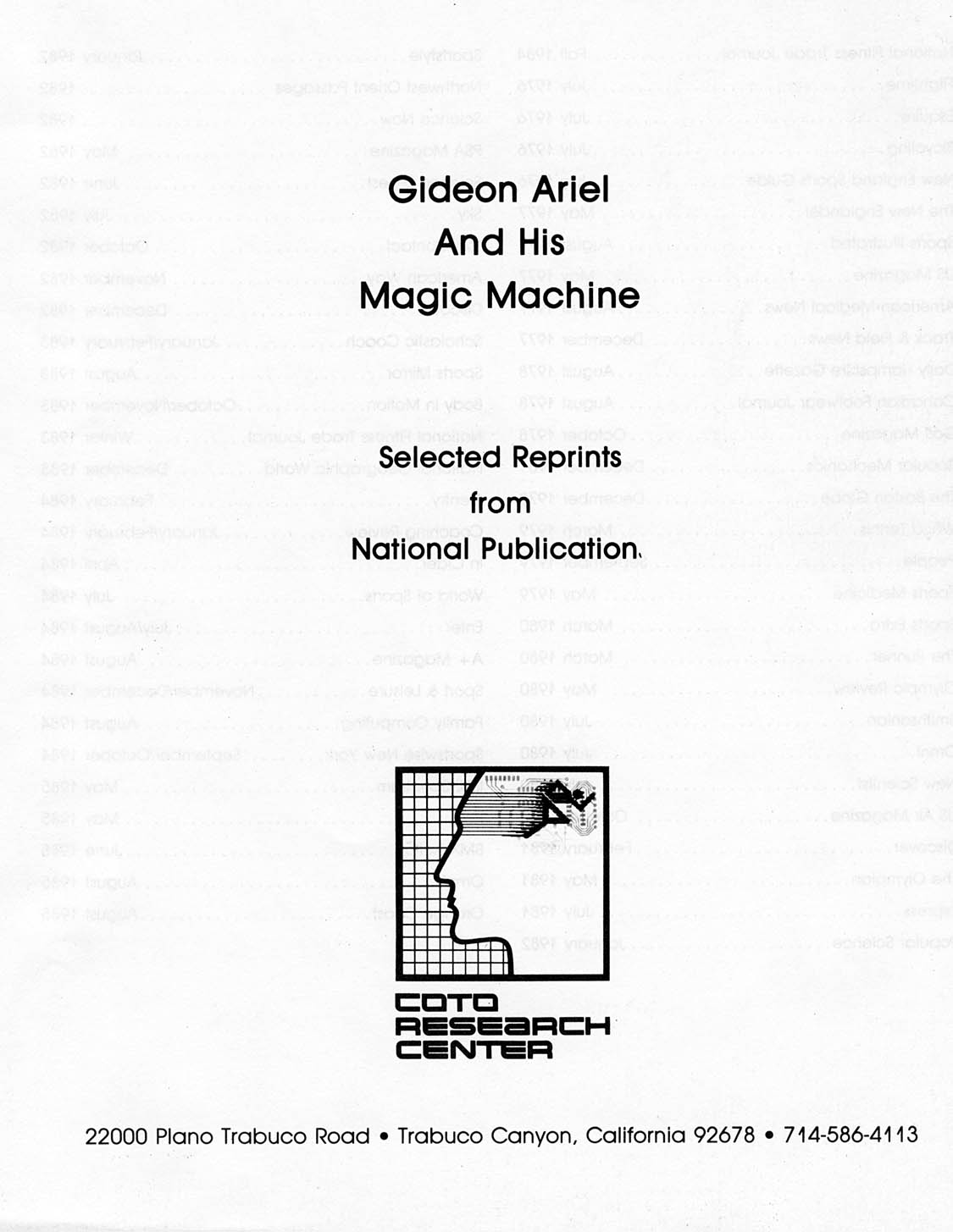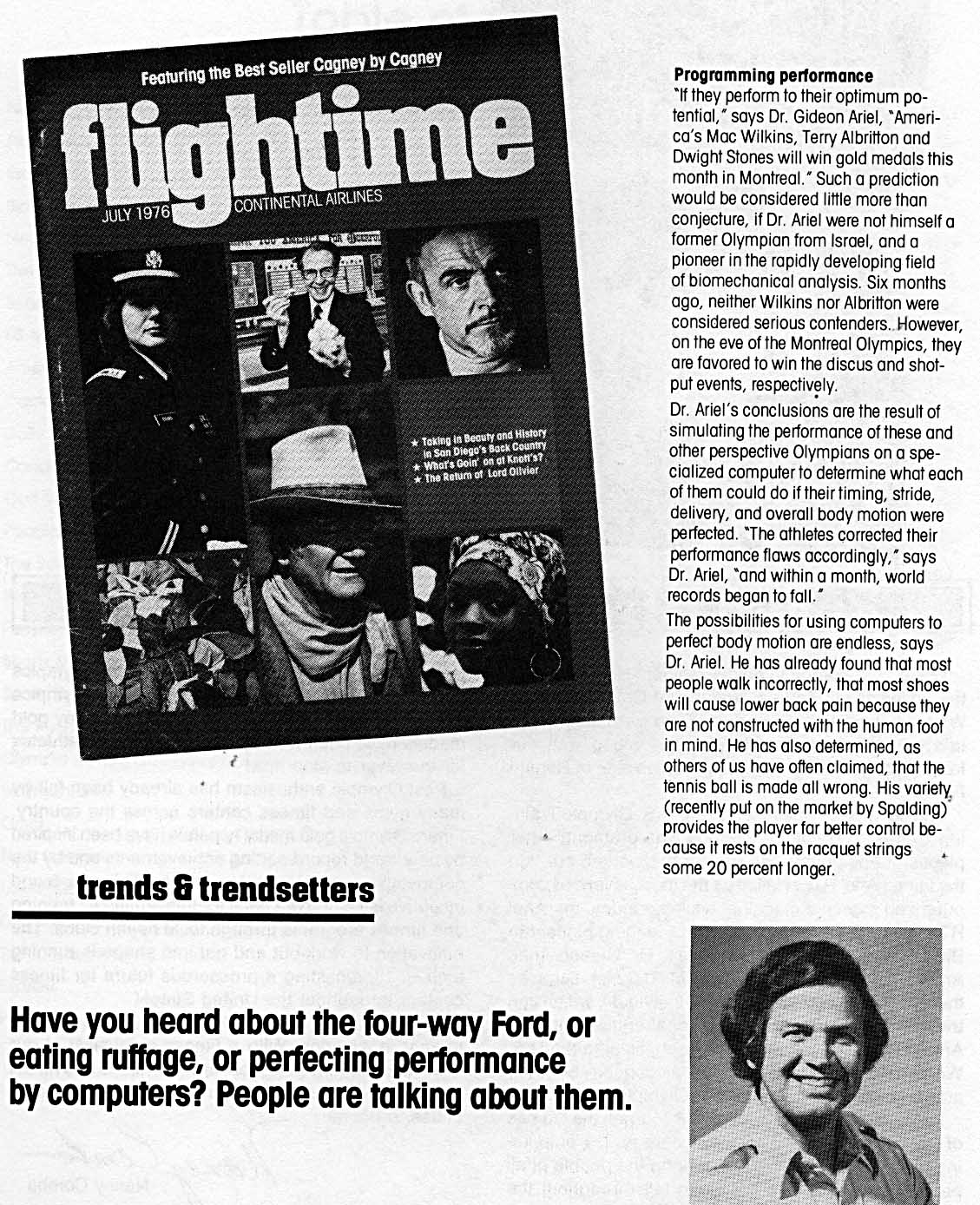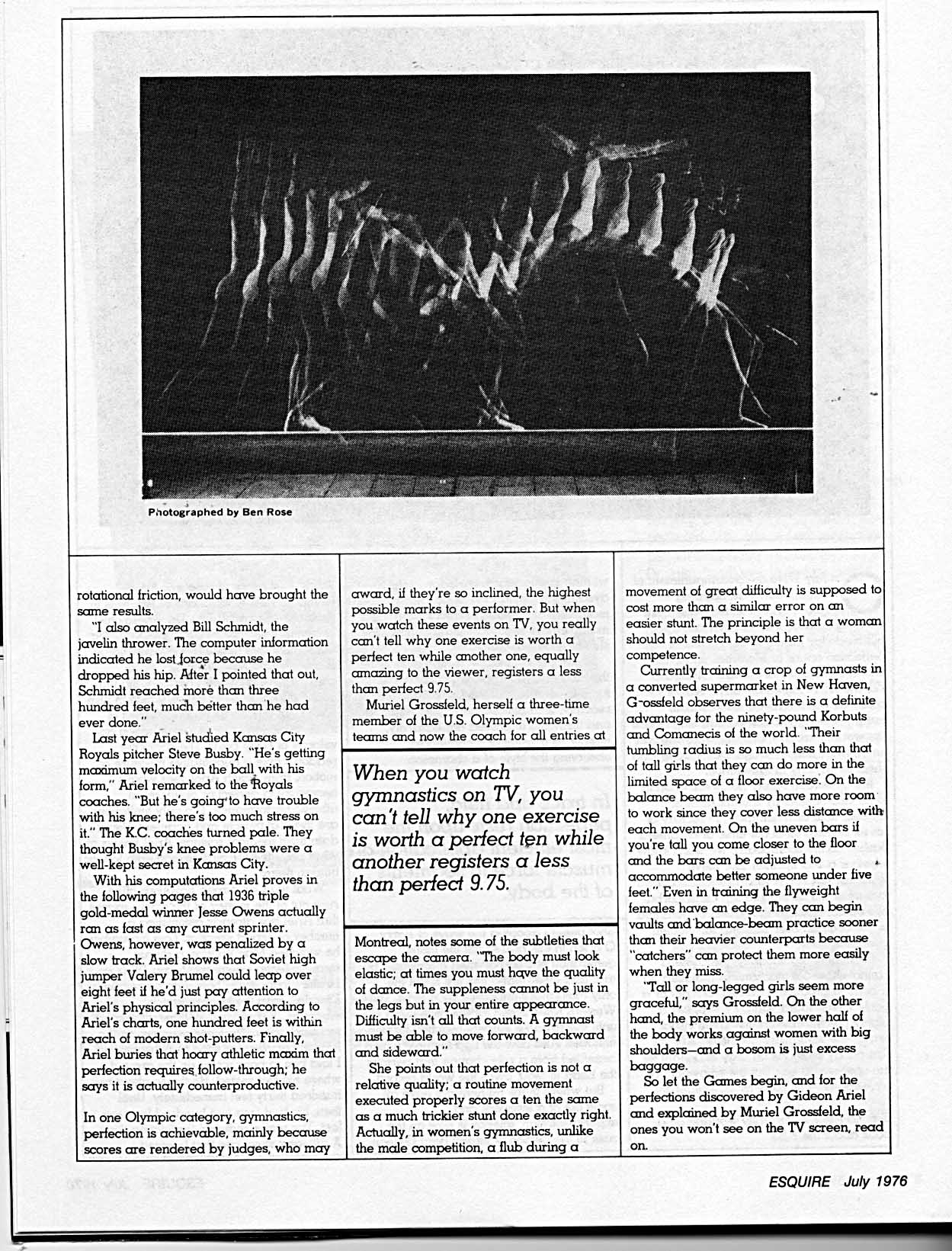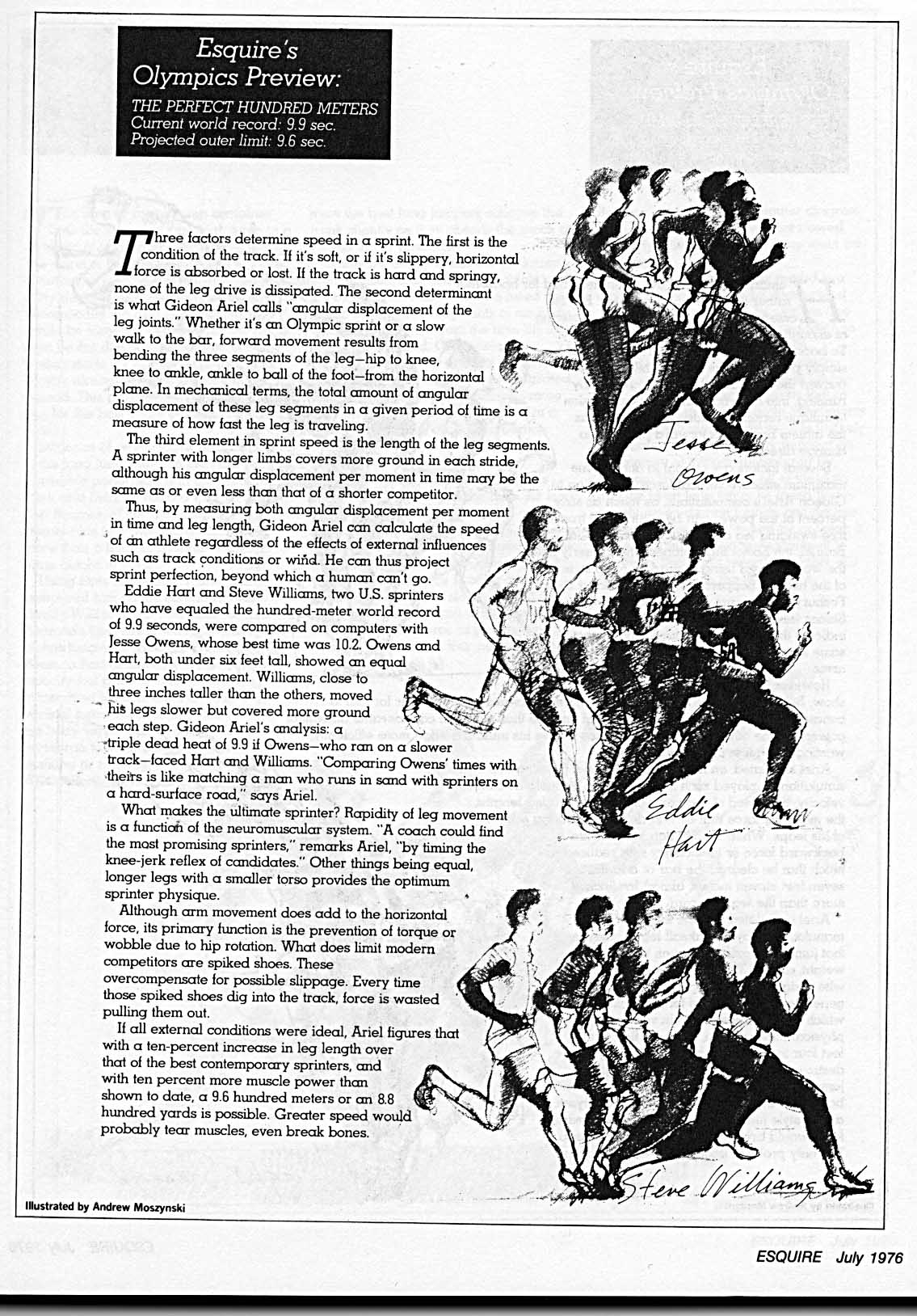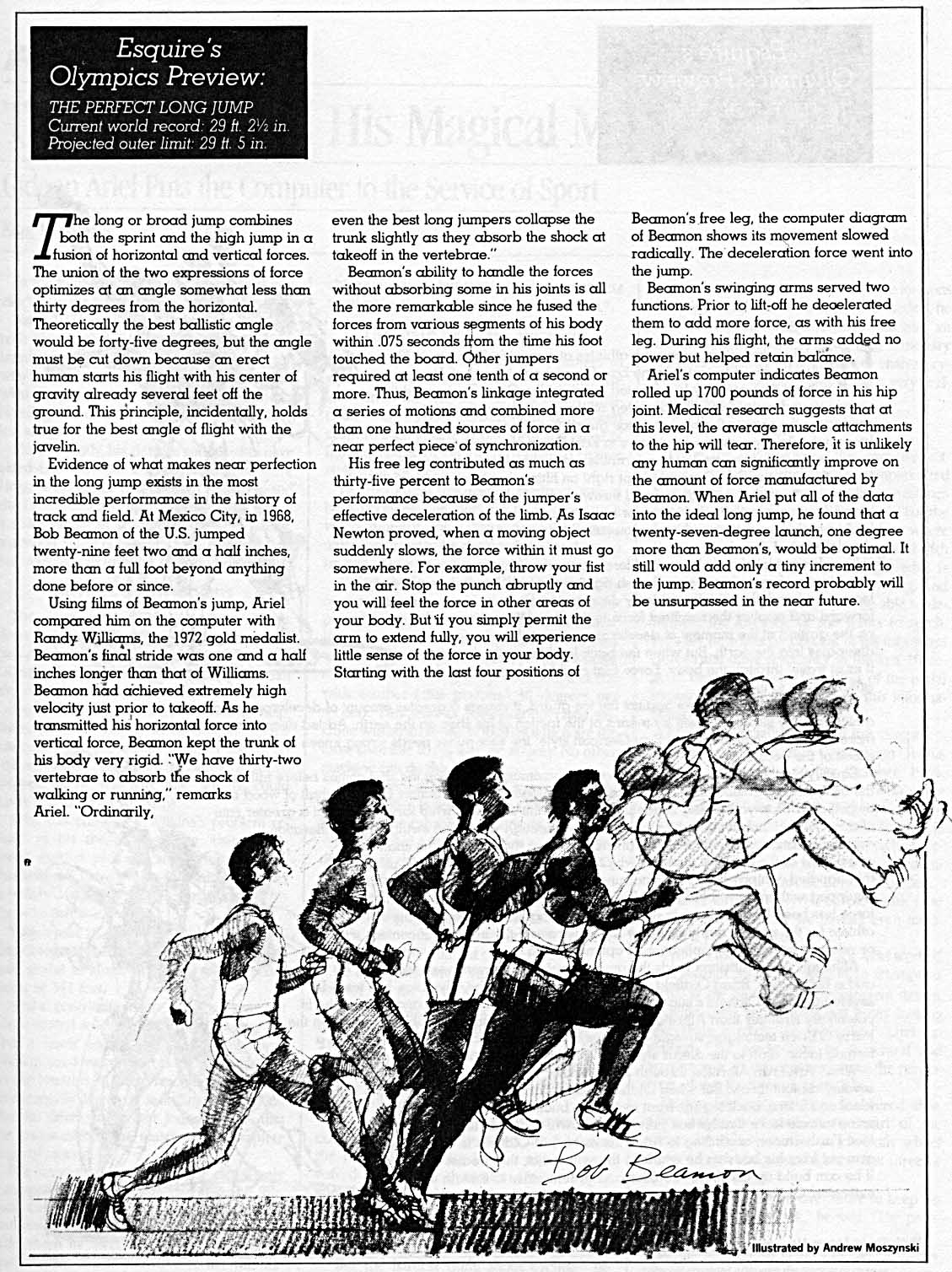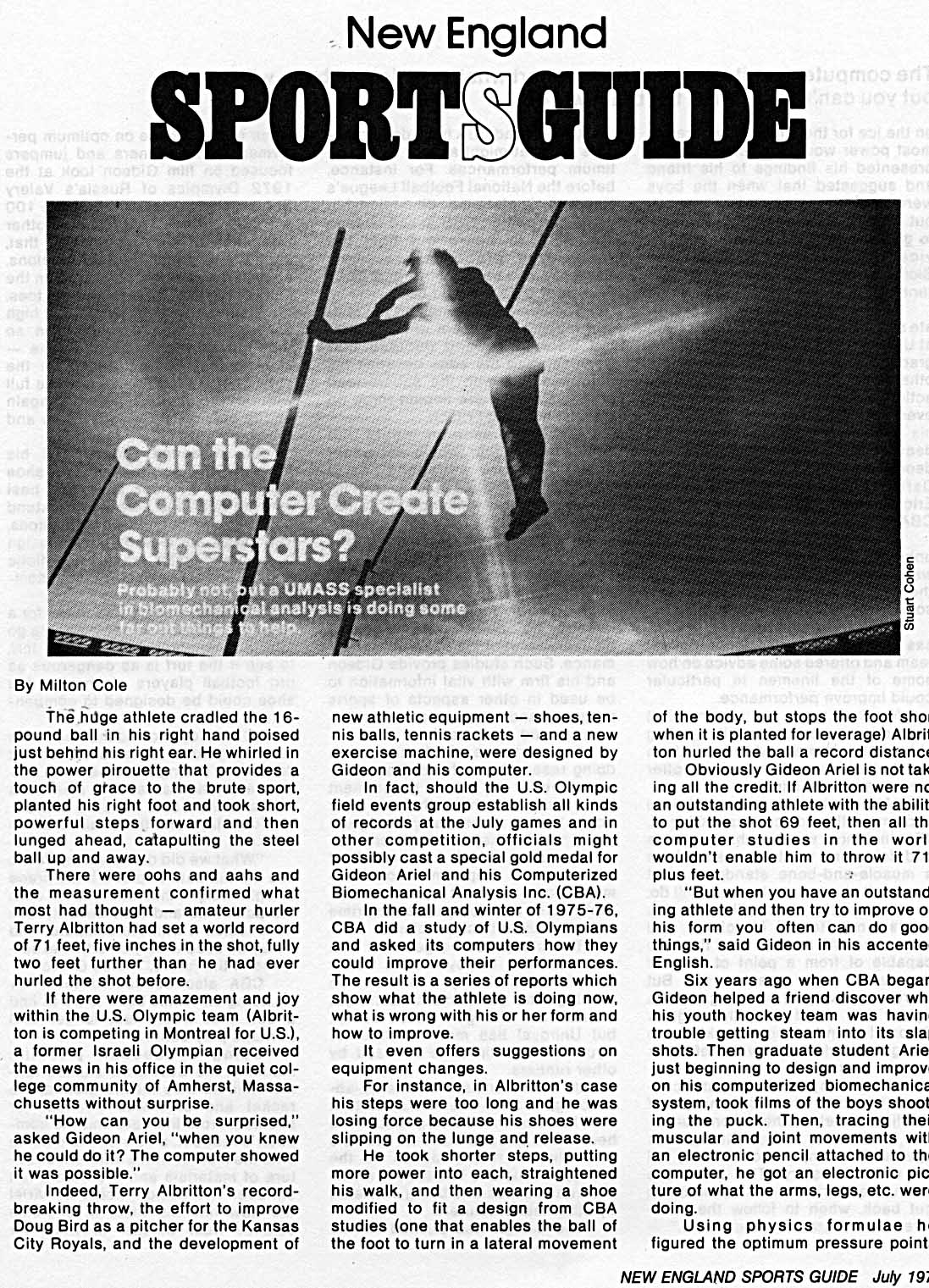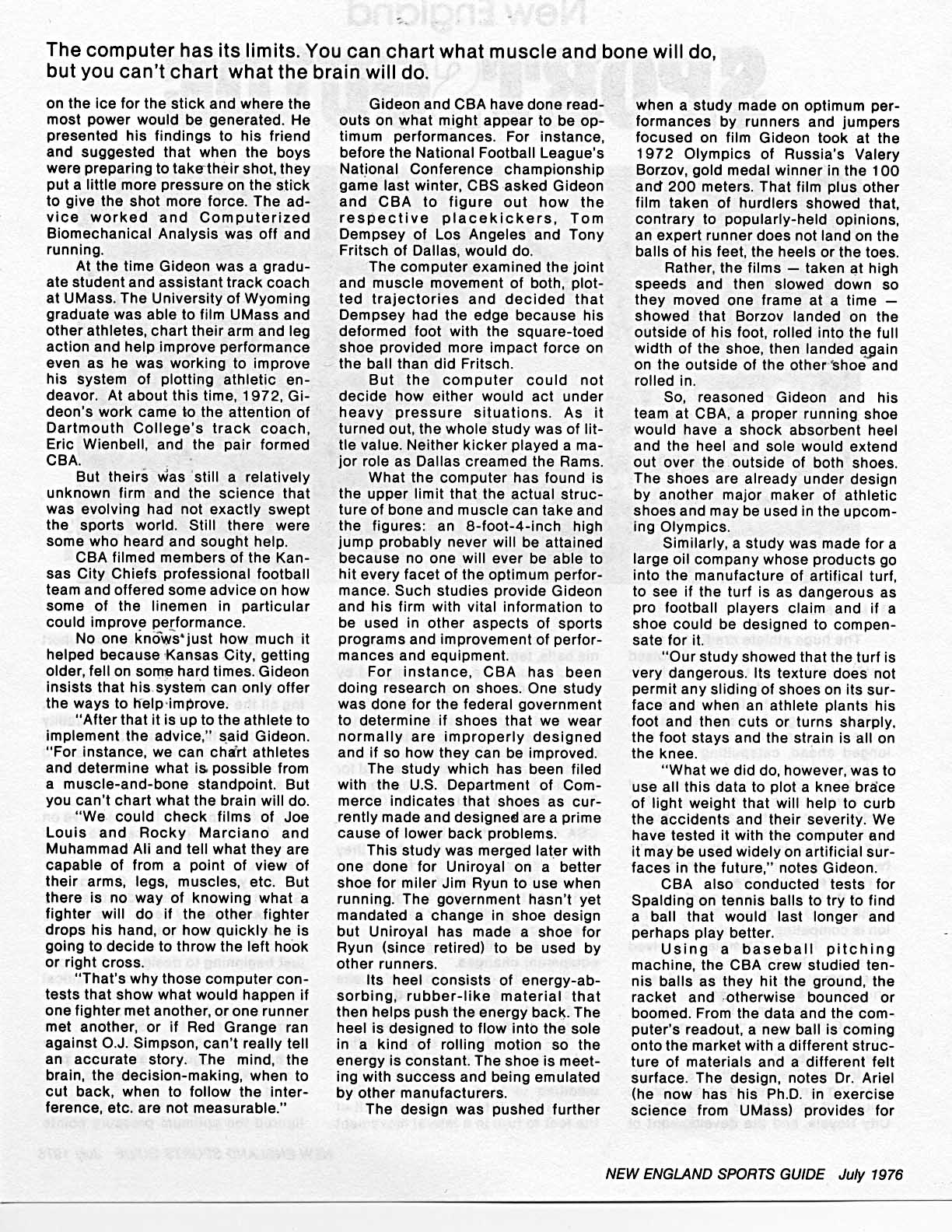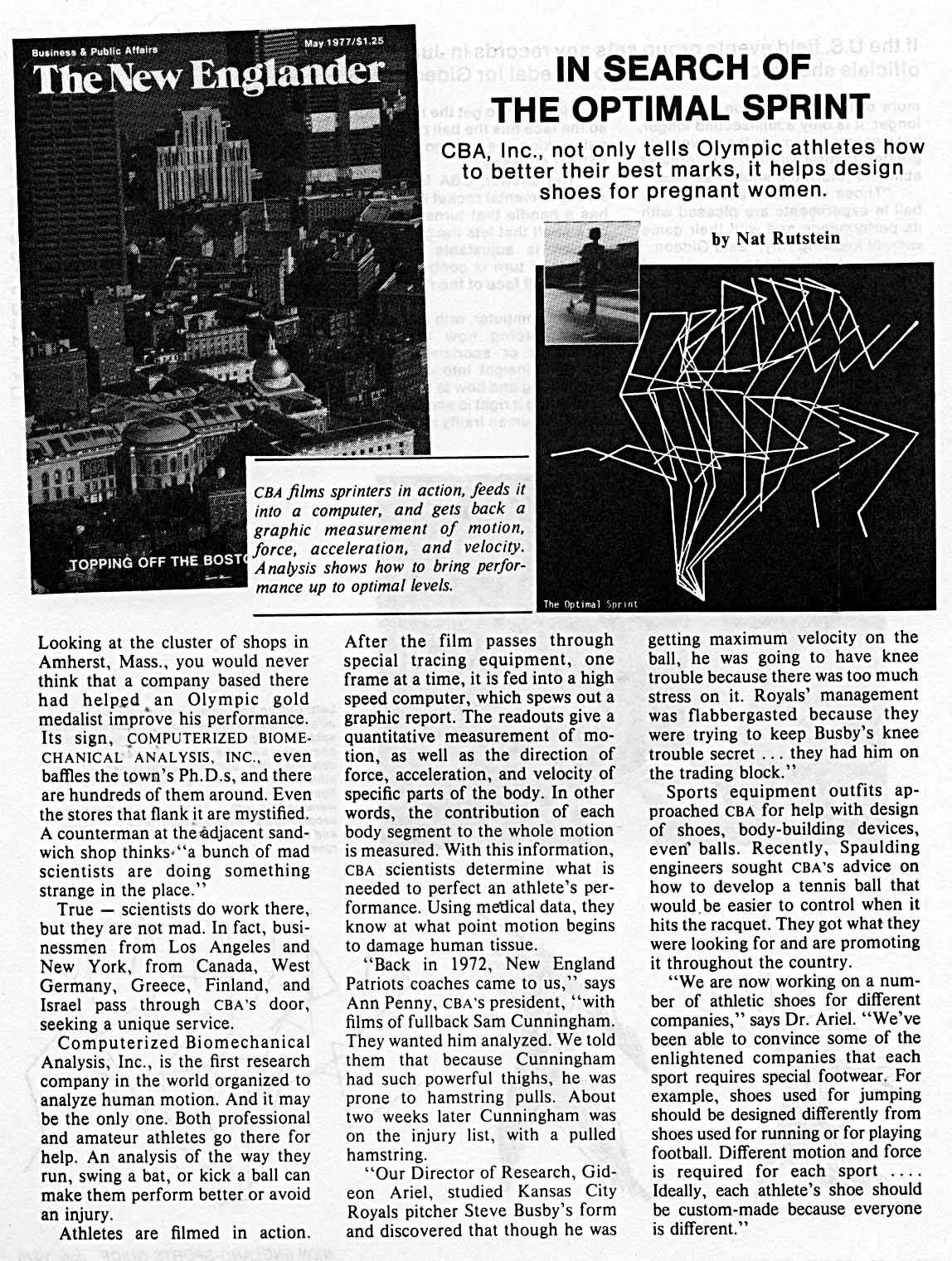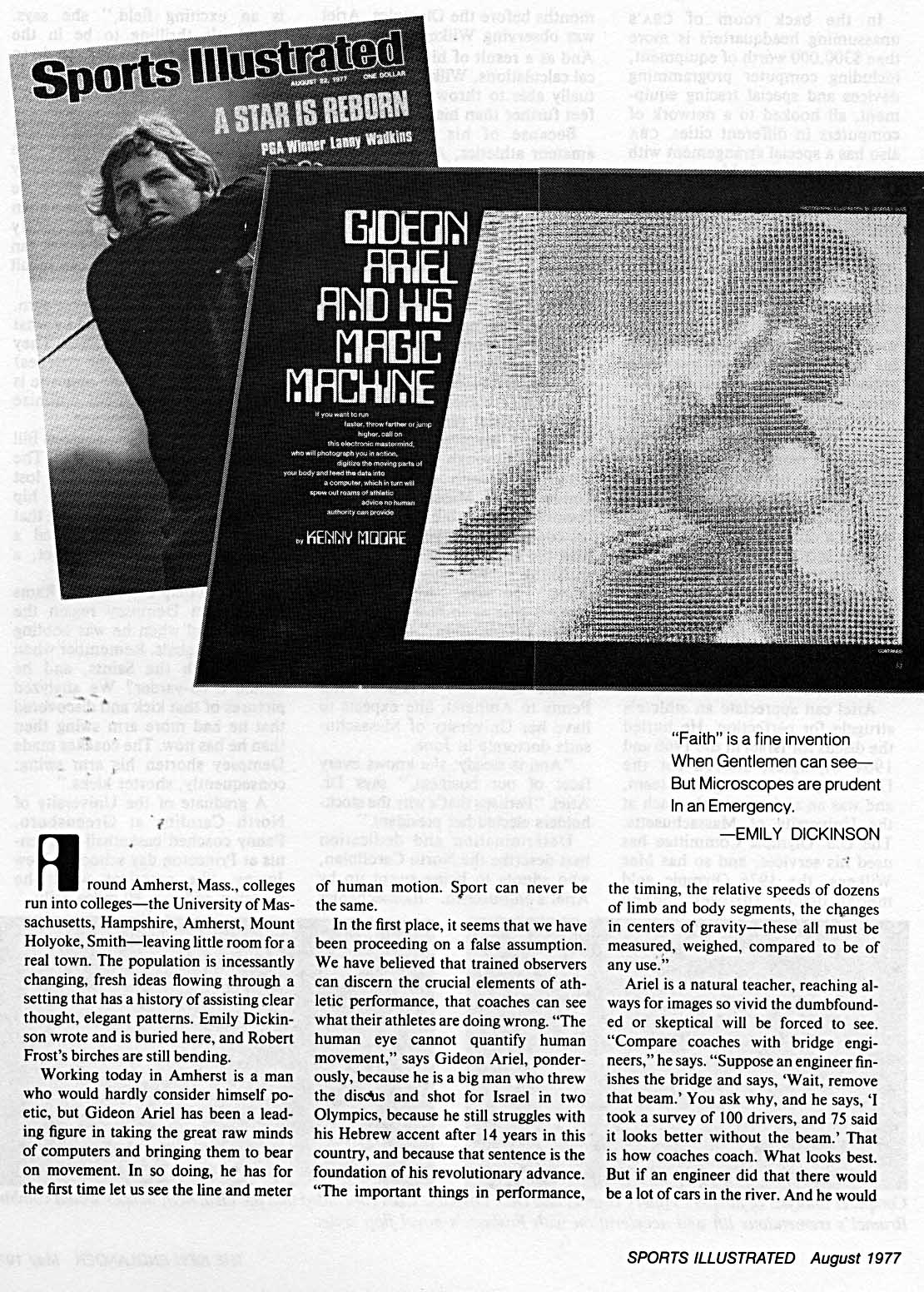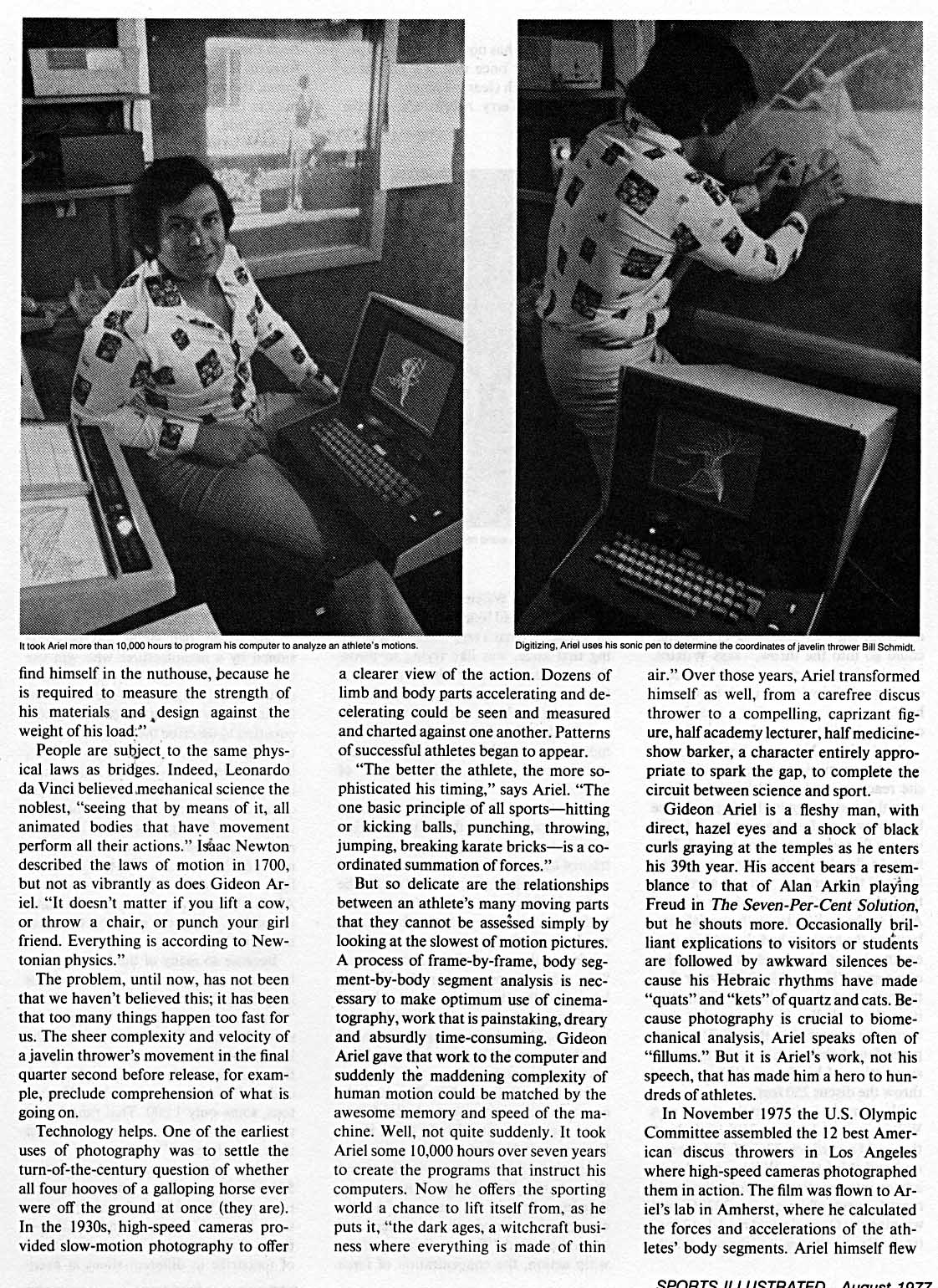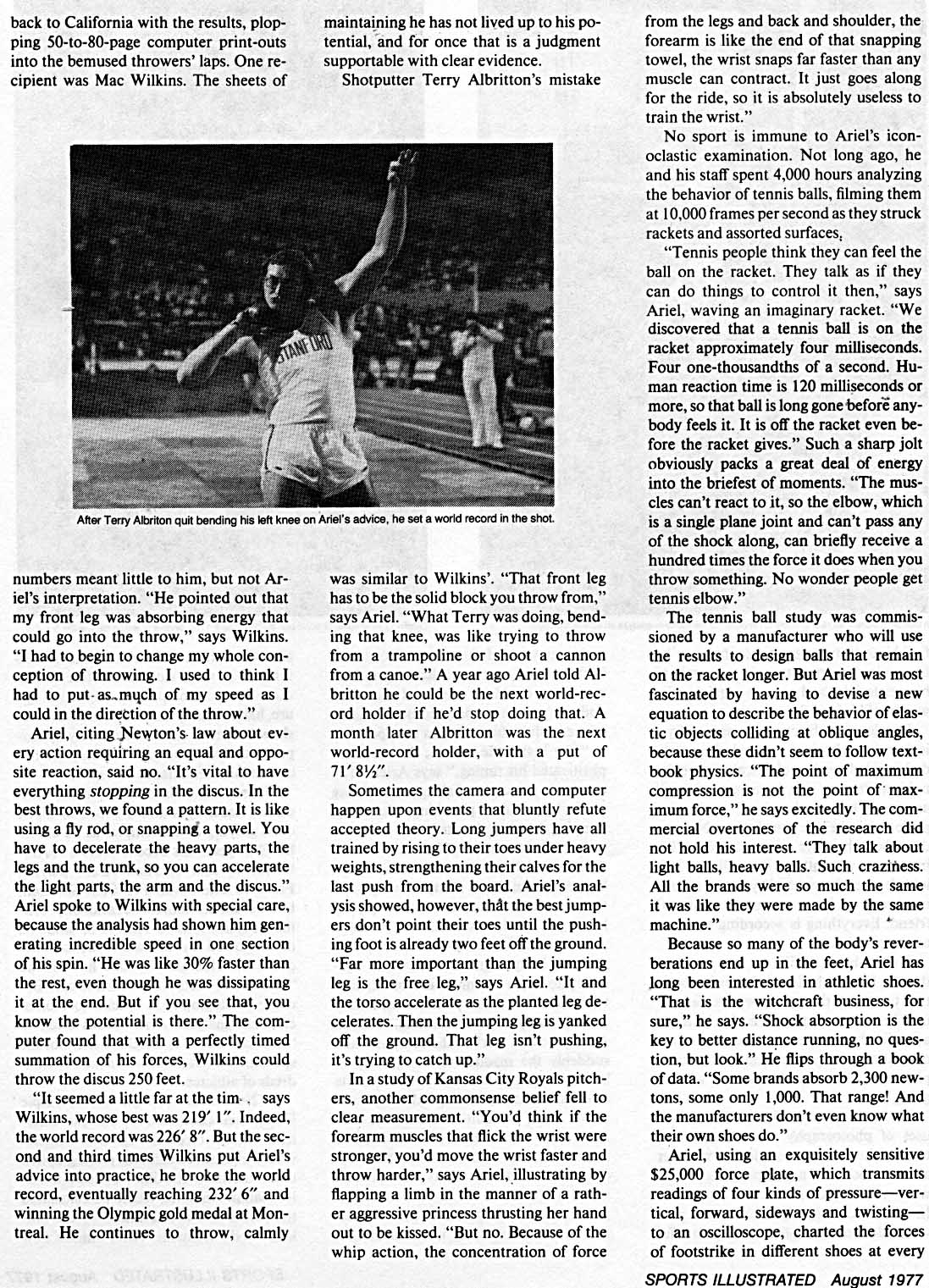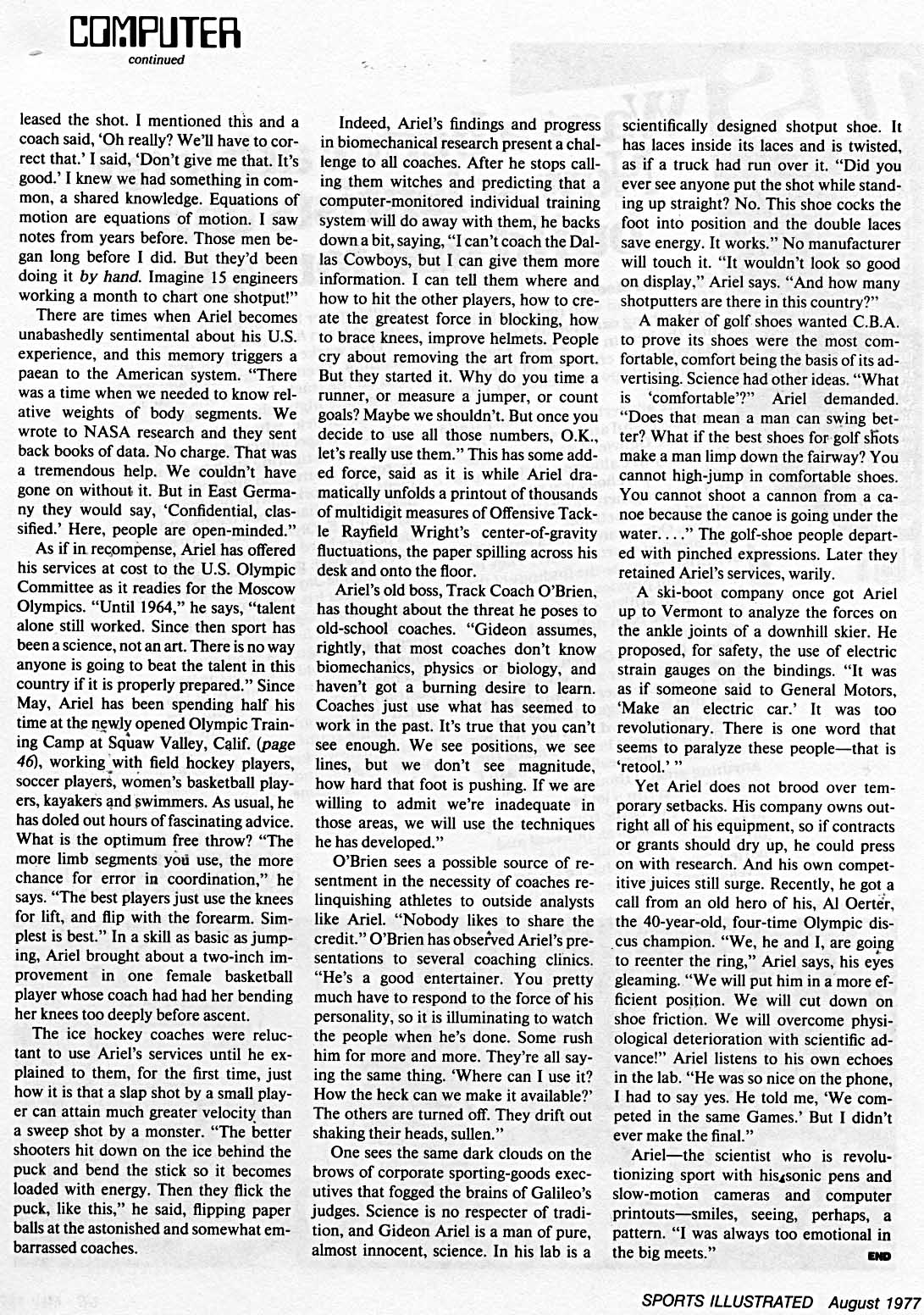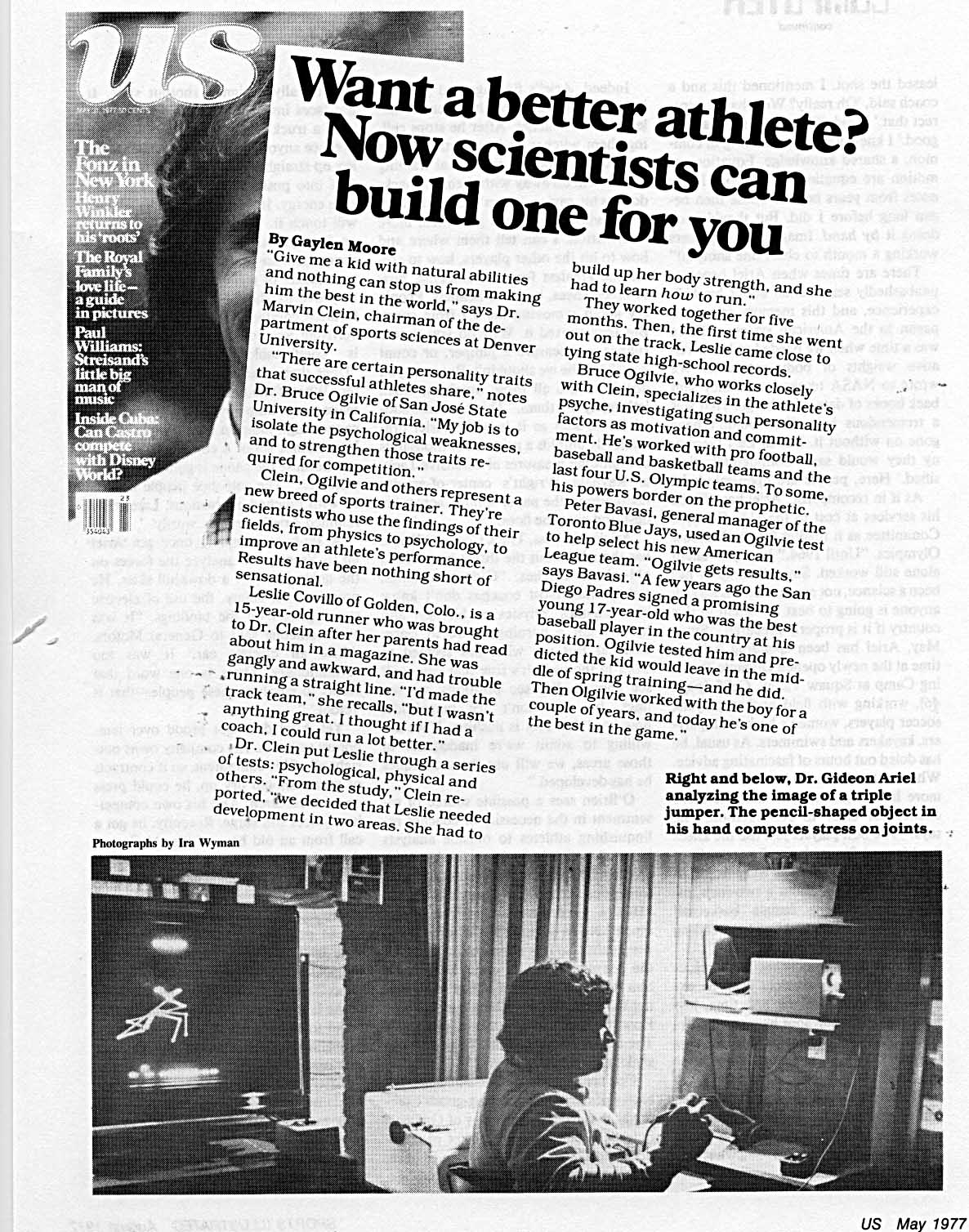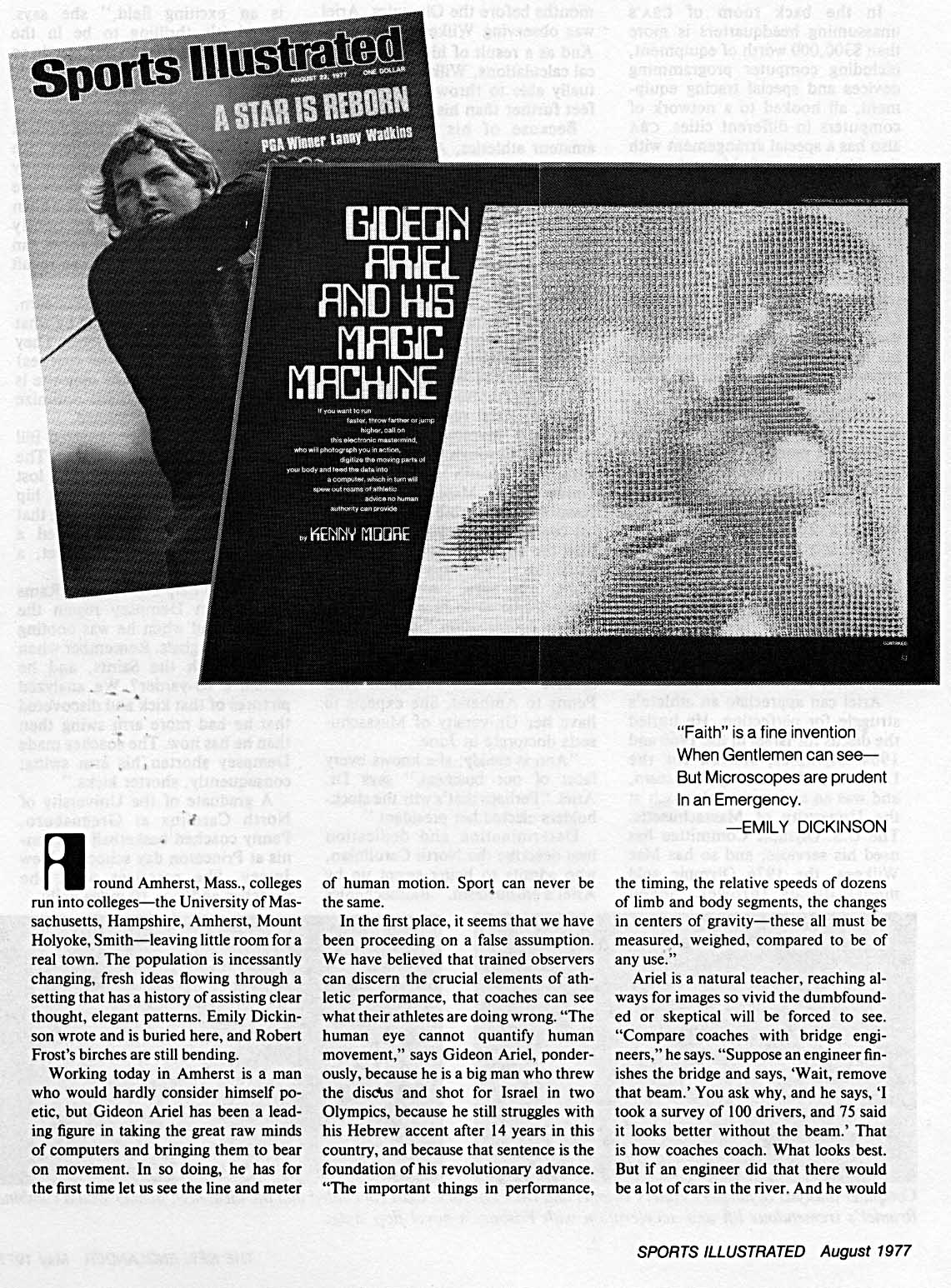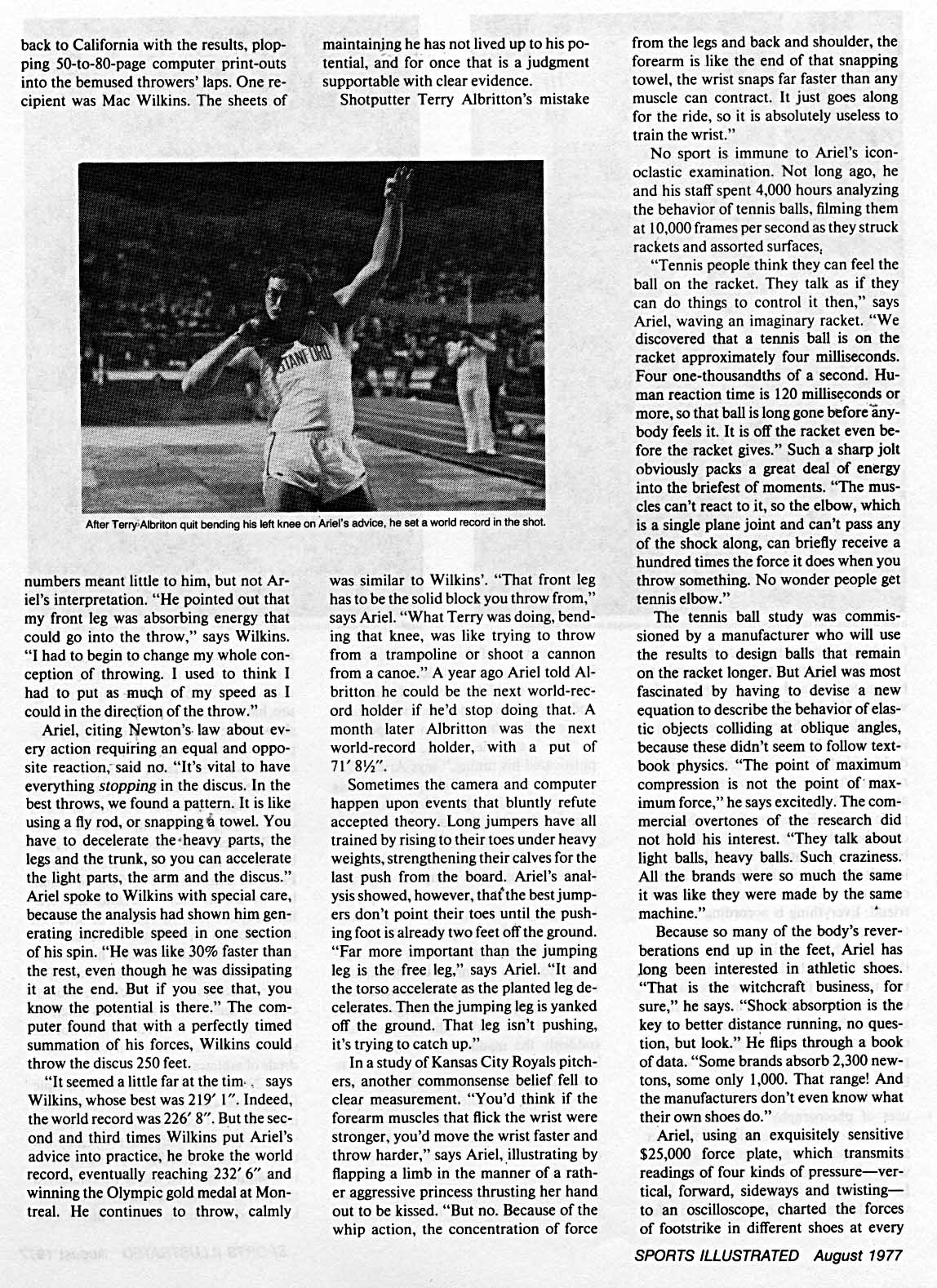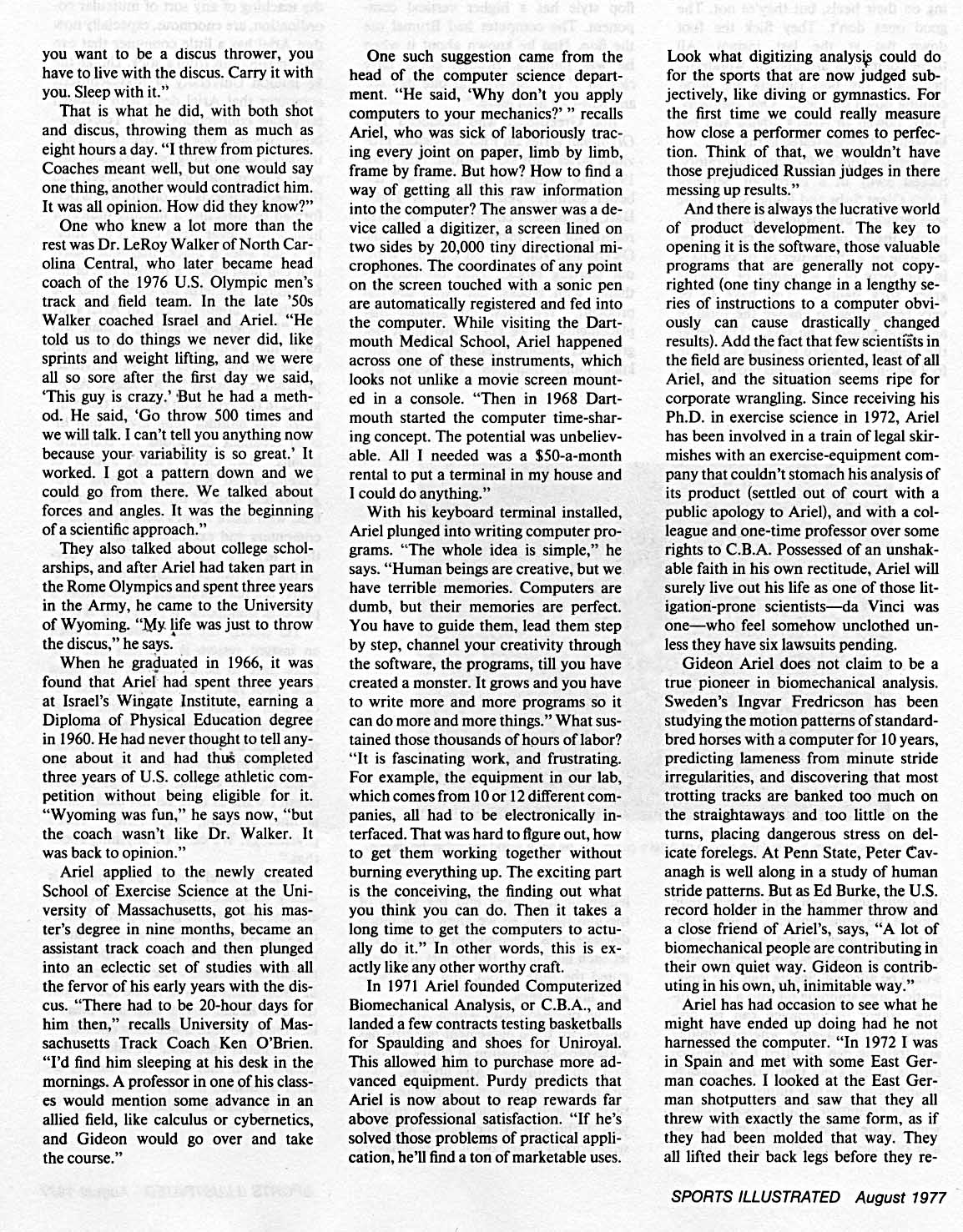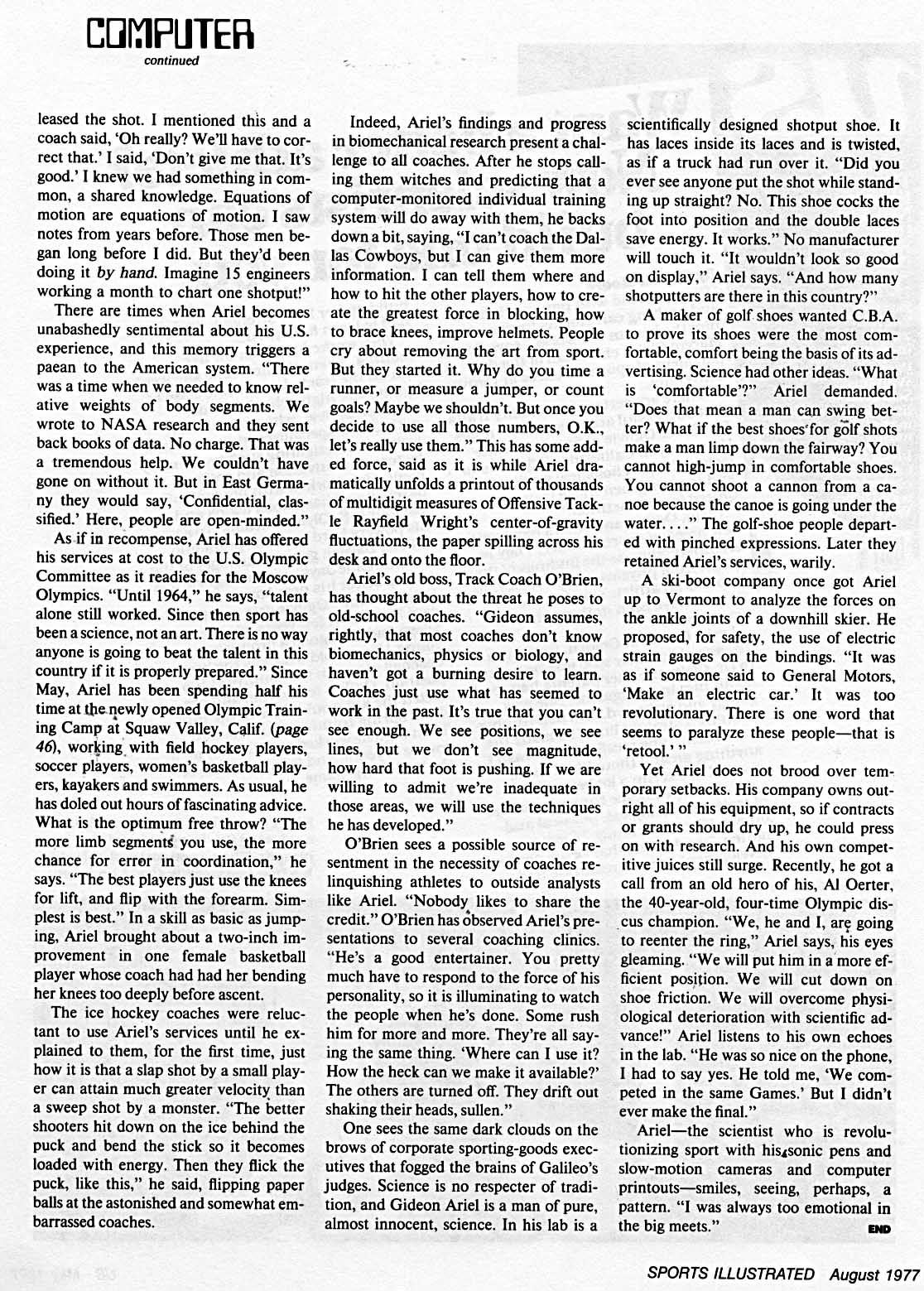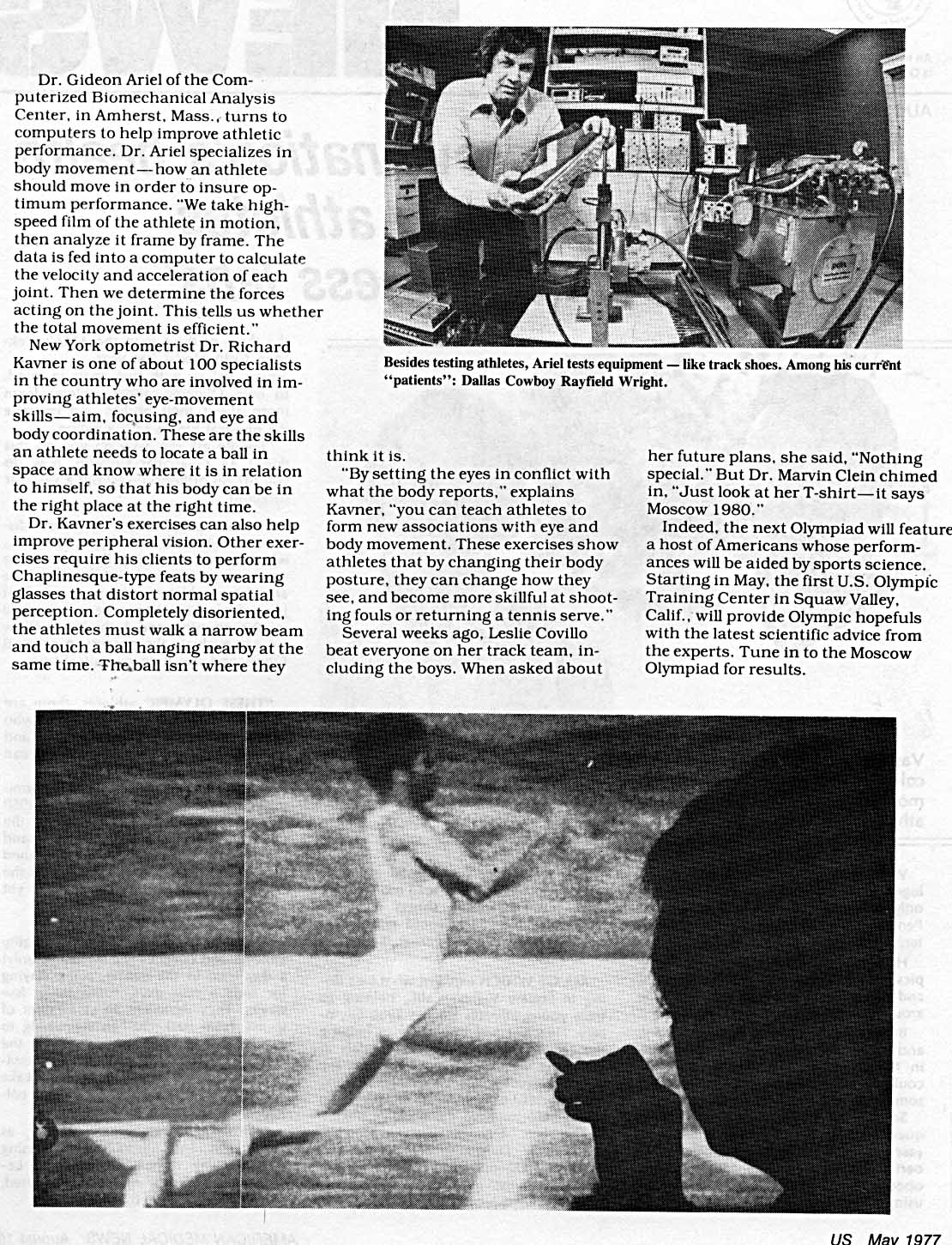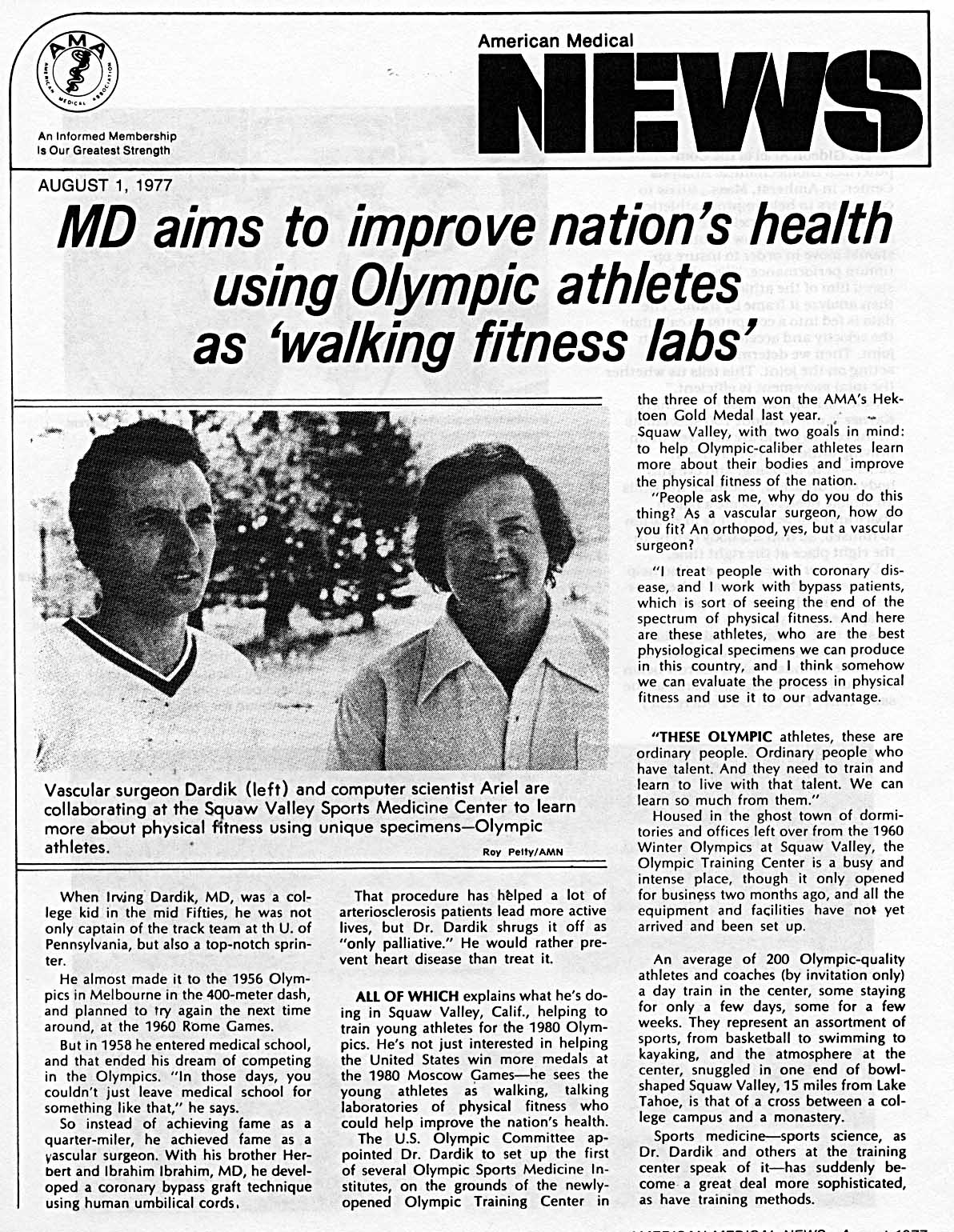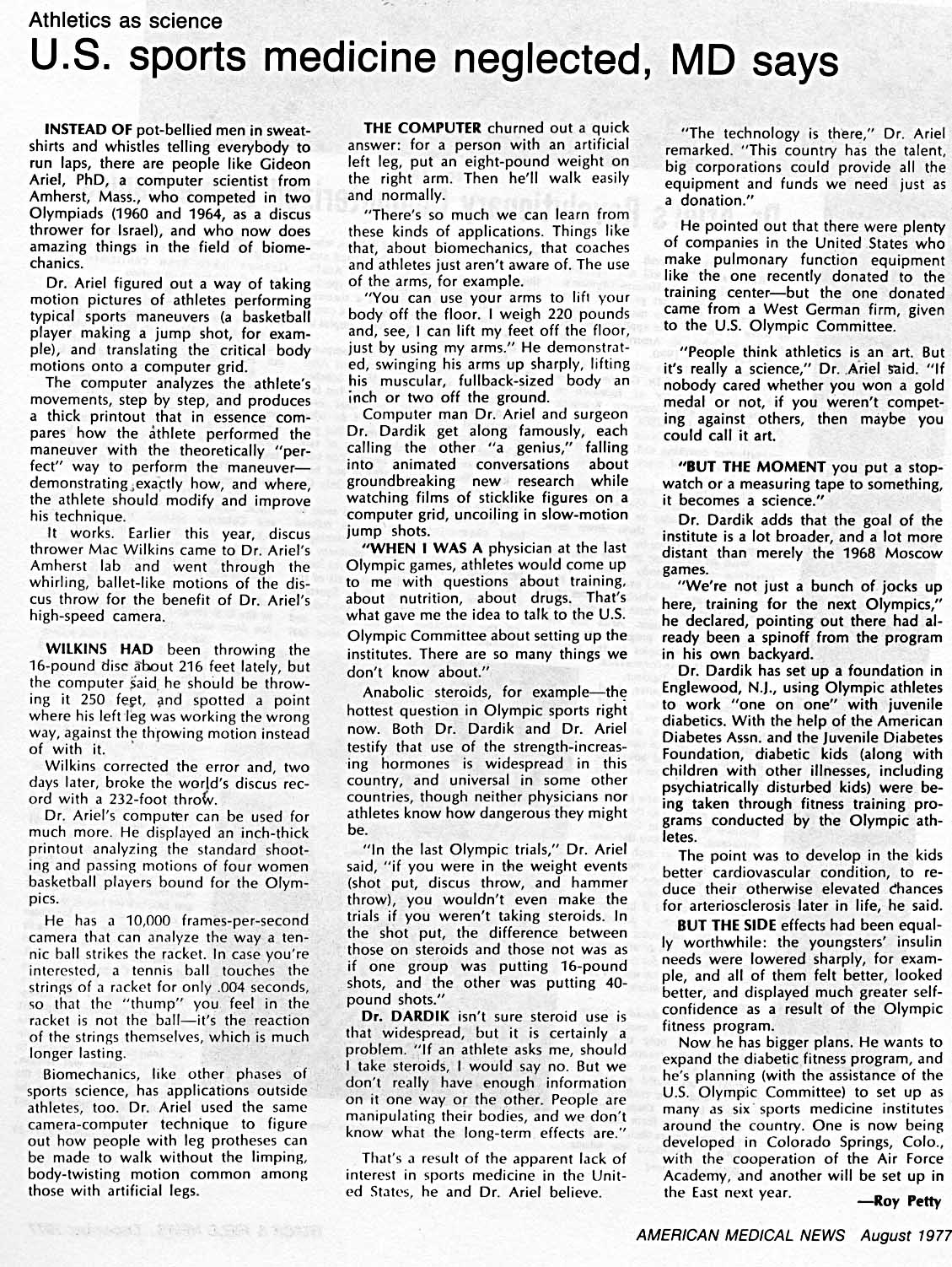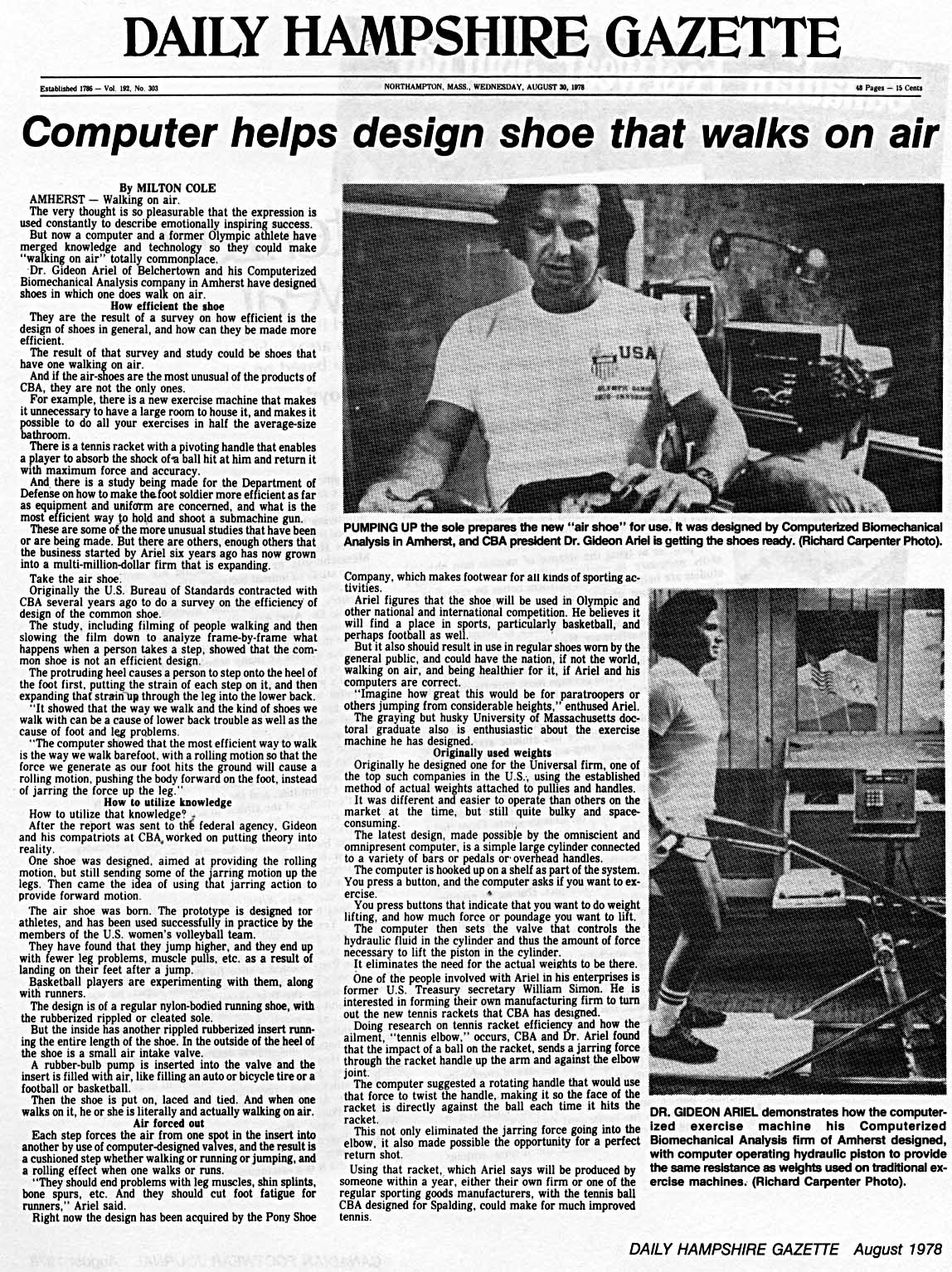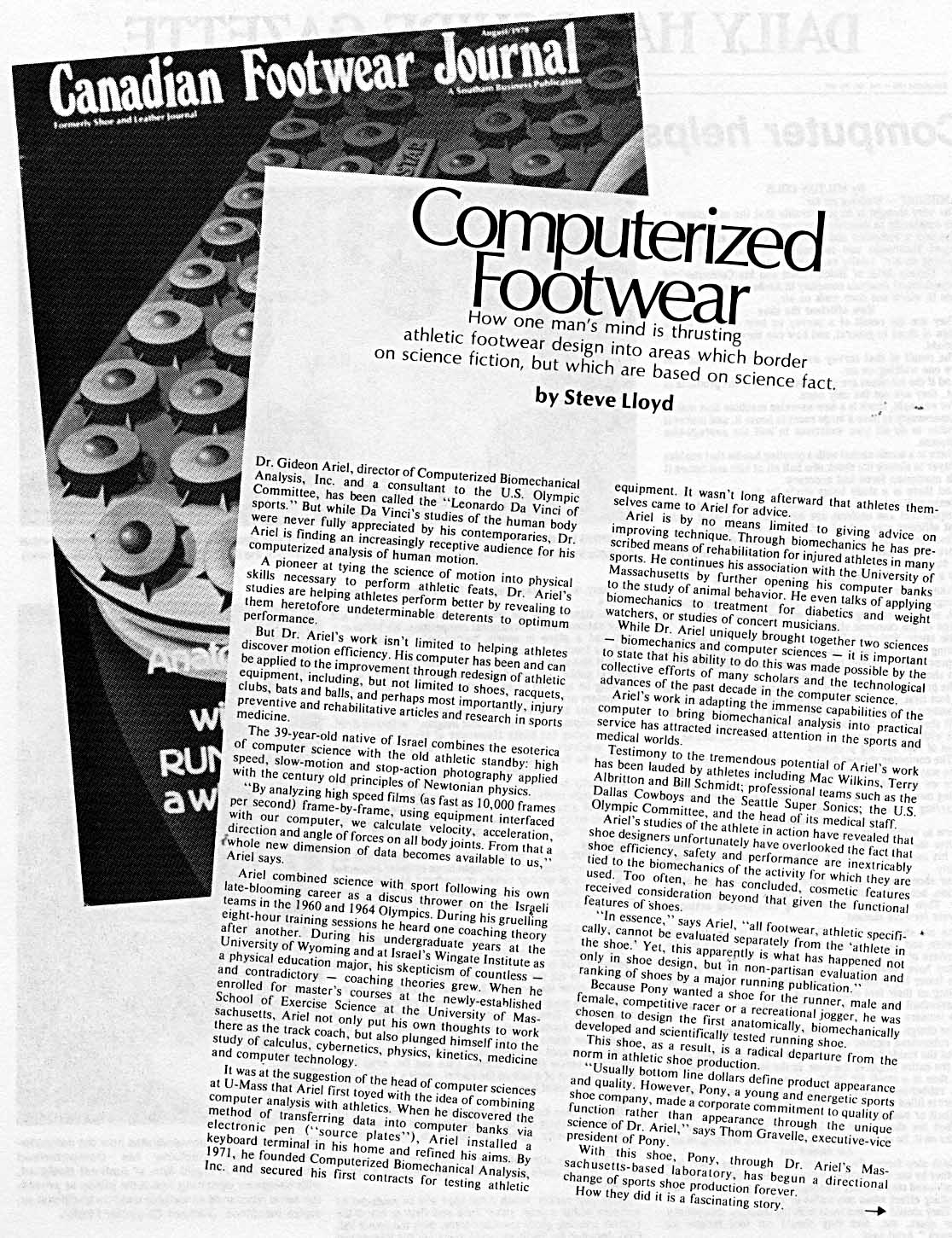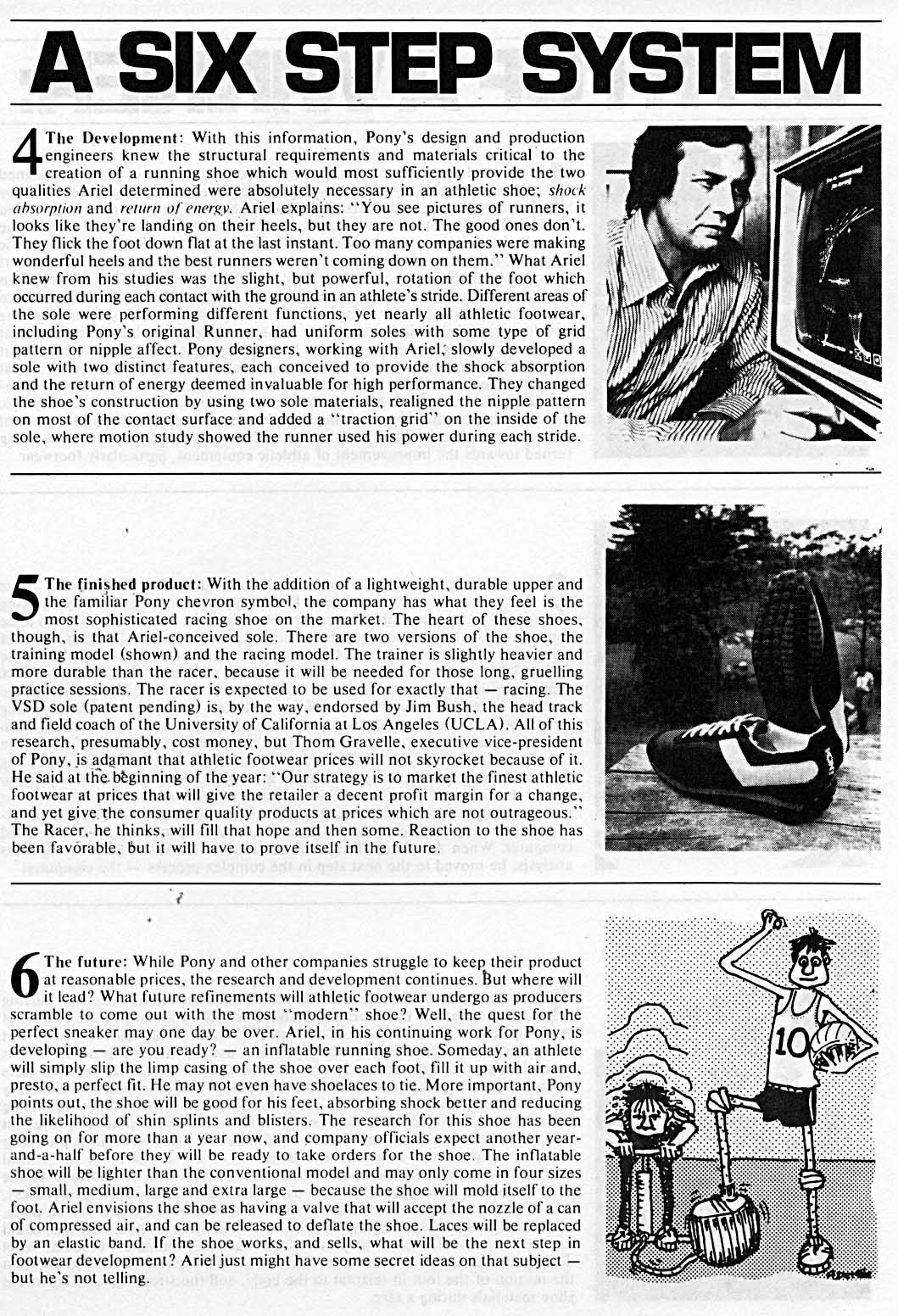Gideon Ariel and his Magic Machine - Book 1
Selected Reprints from National Publication Book 1
By Gideon Ariel in Collection of articles book 1 on Tuesday, January 1, 1980
This article presents a collection of reprints from national publications presented to Gideon Ariel, a pioneer in the field of biomechanical analysis. Ariel's work involves simulating the performance of athletes on a specialized computer to determine their optimum potential. His findings have been used to correct performance flaws in athletes, leading to improved results and world records. The article also discusses Ariel's work in analyzing and improving athletic equipment, and his predictions for future athletic achievements based on his biomechanical analysis.
This article discusses the work of Gideon Ariel, a scientist and former Olympic discus thrower, who uses computerized biomechanical analysis to improve athletic performance. Ariel's technology uses high-speed motion picture cameras and sensors to analyze an athlete's movements and identify areas for improvement. His work has contributed to the training of Olympic athletes, the design of athletic equipment, and the development of new exercise machines. Ariel's research has also led to insights into optimal athletic techniques, such as the ideal launch angle for a long jump or the most effective pedaling stroke for cycling. His work is expected to continue influencing athletic training and performance in the future.
This article discusses the work of Gideon Ariel, a graduate student and assistant track coach at UMass, who used physics to optimize athletic performance. Ariel developed a system called Computerized Biomechanical Analysis (CBA) which uses computer technology to analyze the movements of athletes and suggest improvements. The system was initially used to help improve the performance of hockey players by identifying the optimum pressure point on the ice for the stick. The system was later used to analyze the performance of professional football players and Olympic athletes. The article also discusses how CBA has been used to improve sports equipment design, including shoes and tennis balls. Despite the success of CBA, Ariel acknowledges that the system can only offer ways to improve and it is up to the athlete to implement the advice.
The article discusses the work of Gideon Ariel, a pioneer in the field of biomechanical analysis. Ariel has spent over 10,000 hours over seven years creating programs that use computers to analyze the complex movements of athletes. His work has helped to understand the intricate relationships between an athlete's many moving parts, which cannot be assessed simply by looking at slow-motion pictures. Ariel's work has been used to analyze the movements of discus throwers, runners, and even high jumpers. His analysis has also been used in injury prevention and treatment, as well as in product development for sporting goods. Despite some resistance from traditional coaches and corporate executives, Ariel's work has the potential to revolutionize the field of sports science.
This article from Sports Illustrated, published in August 1977, discusses the work of Gideon Ariel, a scientist who uses technology to analyze and improve athletic performance. Ariel uses high-speed cameras and computers to break down and study the complex movements of athletes, providing insights that challenge traditional coaching methods. His work has led to significant improvements in performance for athletes such as discus thrower Mac Wilkins and shotputter Terry Albritton. Ariel's research has also debunked common beliefs about athletic performance, such as the importance of the forearm muscles in pitching and the role of the jumping leg in long jumps. Despite resistance from manufacturers and traditionalists, Ariel's work continues to revolutionize the field of sports science.
In a comprehensive study of tennis ball behavior, Gideon Ariel and his team discovered that a tennis ball is on the racket for approximately four milliseconds, far less than the human reaction time. This finding has implications for the design of tennis balls and rackets, and could potentially help reduce the incidence of tennis elbow. Ariel also studied the shock absorption of different athletic shoes, finding significant variations between brands. His research has led to the development of a $25,000 force plate that can measure four types of pressure exerted by the foot. Ariel's work has potential applications in injury prevention, treatment, and athletic performance optimization. His research has also led to the development of a computer program that can predict an athlete's optimum technique and coach them towards it.
The article discusses the work of Dr. Gideon Ariel, a scientist who is revolutionizing sports with his innovative use of technology. Ariel uses sonic pens, slow-motion cameras, and computer printouts to analyze and improve athletes' performance. He once proposed the use of electric strain gauges on ski-boot bindings for safety, but the idea was deemed too revolutionary. Despite setbacks, Ariel remains optimistic and continues his research. He recently collaborated with Al Oerter, a four-time Olympic discus champion, to improve his performance using scientific advancements. Ariel's work represents a new breed of sports training, combining science and technology to enhance athletic performance.
Tip: use the left and right arrow keys
Selected Reprints from National Publications
Presented to Gideon Ariel
Hope to have your work aboard soon.
This flag and patch were flown aboard Chalenger (STS-8). the first night launch and landing of the Space Shuttle. Aug. 30 - Sept. 5. 1983.
Gideon Ariel and his Magic Machine
Selected Reprints from National Publication,
COTO RESEARCH CENTER
22000 Plano Trabuco Road | Trabuco Canyon, California 92678 | 714-586-4113
Table of Contents
National Fitness Trade Journal Fall 1984
Flightime July 1976
Esquire July 1976
Bicycling July 1976
New England Sports Guide July 1976
The New Englander May 1977
Sports Illustrated August 1977
US Magazine May 1977
American Medical News August 1977
Track & Field News December 1977
Daily Hampshire Gazette August 1978
Canadian Footwear Journal August 1978
Golf Magazine October 1978
Popular Mechanics December 1981
The Boston Globe December 1978
World Tennis March 1979
People September 1979
Sports Medicine May 1979
Sports Extra March 1980
The Runner March 1980
Olympic Review May 1980
Smithsonian July 1980
Omni July 1980
New Scientist July 1980
US Air Magazine October 1980
Discover February 1981
The Olympian May 1981
Express July 1981
Popular Science January 1982
Sportstyle January 1982
Northwest Orient Passages 1982
Science Now 1982
PSA Magazine May 1982
Science Digest June 1982
Sky July 1982
321 Contact October 1982
American Way November 1982
Discover December 1982
Scholastic Coach January/February 1983
Sports Mirror August 1983
Body In Motion October/November 1983
National Fitness Trade Journal Winter 1983
National Geographic World December 1983
Gentry February 1984
Coaching Review January/February 1984
In Cider April 1984
World of Sports July 1984
Enter July/August 1984
A+ Magazine August 1984
Sport & Leisure November/December 1984
Family Computing August 1984
Sportswise New York September/October 1984
IEEE Spectrum May 1985
Polo May 1985
BMX Action June 1985
Omni August 1985
Orange Coast August 1985
Programming performance
'If they perform to their optimum potential,' says Dr. Gideon Ariel, 'America's Mac Wilkins, Terry Albritton and Dwight Stones will win gold medals this month in Montreal.' Such a prediction would be considered little more than conjecture, if Dr. Ariel were not himself a former Olympian from Israel, and a pioneer in the rapidly developing field of biomechanical analysis. Six months ago, neither Wilkins nor Albritton were considered serious contenders. However, on the eve of the Montreal Olympics, they are favored to win the discus and shotput events, respectively.
Dr. Ariel's conclusions are the result of simulating the performance of these and other perspective Olympians on a specialized computer to determine what each of them could do if their timing, stride, delivery, and overall body motion were perfected. 'The athletes corrected their performance flaws accordingly,' says Dr. Ariel, 'and within a month, world records began to fall.'
The possibilities for using computers to perfect body motion are endless, says Dr. Ariel. He has already found that most people walk incorrectly, that most shoes will cause lower back pain because they are not constructed with the human foot in mind. He has also determined, as others of us have often claimed, that the tennis ball is made all wrong. His variety, (recently put on the market by Spalding) provides the player far better control because it rests on the racquet strings some 20 percent longer.
JULY, 1976
VOLUME 86 No. 1 WHOLE No. 512
Esquire's
Olympics Preview: How To Know A Perfect Performance When You See One
by Gerald Astor
On July 17, to the accompaniment of booming cannons, flapping pigeons and assorted noise from the likes of the queen of England, a billion-dollar tribute to the pursuit of perfection opens at Montreal under the title of the Games of the XXI Olympiad For the following fiftt en days, ABC's TV cameras will long-lens, slow-motion, instant-replay, split-screen and stop-action the world's greatest athletes, who will run, jump, twist, heave, stroke, guide, steer and shoot in an orgy of excellence.
But perfection rarely holds still enough to be anatomized by a camera lens. Indeed, until commentator Jim McKay or his ilk advises us of the time, or a camera flashes on the scoreboard, we won't know whether a U.S. sprinter like Steve Williams has run a world record hundred meters or the Soviet Union's Olga Korbut has outdone Nadia Comaneci of Romania in the optional floor exercise for women gymnasts.
Even more significantly, the camera cannot show the mechanics employed by a body to produce a perfect shot put or a perfect Tsukahara vault. TV supplies a highly pleasurable caress to the visual sense-the same way Beethoven's Ninth Symphony provides an orgy of delight for the unschooled ear. But the enjoyment of athletics-as well as of music-increases with an intellectual knowledge of the dynamics, whether it is Beethoven's manipulation of notes or Terry Albritton's manipulation of muscle tissue to move the shot seventy-one feet.
Gerald Astor is currently working on a book about the F.B.I.
In track and field, perfection rests upon the most efficient application of muscle. force to segments of the body. Until recently, techniques for running, jumping and throwing improved haphazardly, mainly as a result of a challenger observing the style oY a champion
In track and field, perfection rests upon the most efficient application of muscle force to segments of the body.
Shot-putters adopted the ways of Parry O'Brien in the 1950's until the latest generation of iron-ball men discovered by trial and error that a martini is not the only thing that's improved by a twist. The Western roll sufficed for the high jump until the straddle leapers reached higher altitudes. And now the flop method, which benefited from a rule change that permits the head to lead, owns the world record.
But where these refinements have all come out of guesswork and experimentation, science is now on the case in the person of Israeli-born Gideon
Ariel. As director of research for Computerized Biomechanical Analysis in Amherst, Massachusetts, Dr. Ariel's chief business is testing and designing athletic equipment that maximizes effective force. Since 1972, he has also been photographing athletes and feeding this visual data into a computer, which in turn spews out a graphic report in terms of force, direction of force, acceleration and velocity of body parts. The computer readouts give a quantitative measure of motion, from which Ariel sees what's necessary to perfect or optimize an athletic performance. The only limitations are those of muscle and ligament. Using data from medical science, Ariel knows at what point the forces exerted begin to tear human tissue.
What wins on paper, however, often runs out of the money at the track-except that Ariel has already astonished a number of expert skeptics. Last November he watched Mac Wilkins, a discus thrower (Ariel's own event as a 1964 Israeli Olympian). "Based on calculations I made," says the biomechanical engineer, "I could see Wilkins dissipated too much muscular force overcoming the friction between his shoe and the ground I told him to pour water on the ground where his foot rested. He threw about two hundred thirty feet immediately. Until then, his best was two hundred fourteen feet. The water reduced the friction drag. A different shoe, one that lowered
Photographed by Ben Rose
rotational friction, would have brought the same results.
"I also analyzed Bill Schmidt, the javelin thrower. The computer information indicated he lost once because he dropped his hip. Alter I pointed that out, Schmidt reached more than three hundred feet, much better than he had ever done."
Last year Ariel studied Kansas City Royals pitcher Steve Busby. "He's getting maximum velocity on the ball with his form," Ariel remarked to the 'Iloyals coaches. "But he's going-to have trouble with his knee; there's too much stress on it." The K.C. coaches turned pale. They thought Busby's knee problems were a well-kept secret in Kansas City.
With his computations Ariel proves in the following pages that 1936 triple gold-medal winner Jesse Owens actually ran as fast as any current sprinter. Owens, however, was penalized by a slow track. Ariel shows that Soviet high jumper Valery Brumel could leap over eight feet if he'd just pay attention to Ariel's physical principles. According to Ariel's charts, one hundred feet is within reach of modern shot-putters. Finally, Ariel buries that hoary athletic maxim that perfection requires follow-through; he says it is actually counterproductive.
In one Olympic category, gymnastics, perfection is achievable, mainly because scores are rendered by judges, who may award, if they're so inclined, the highest possible marks to a performer. But when you watch these events on TV, you really can't tell why one exercise is worth a perfect ten while another one, equally amazing to the viewer, registers a less than perfect 9.75.
Muriel Grossfeld, herself a three-time member of the U.S. Olympic women's teams and now the coach for all entries at
When you watch gymnastics on TV, you can't fell why one exercise is worth a perfect ton while another registers a less than perfect 9.75.
Montreal, notes some of the subtleties that escape the camera. 'The body must look elastic; at times you must have the quality of dance. The suppleness cannot be just in the legs but in your entire appearance. Difficulty isn't all that counts. A gymnast must be able to move forward, backward and sideward."
She points out that perfection is not a relative quality; a routine movement executed properly scores a ten the same as a much trickier stunt done exactly right. Actually, in women's gymnastics, unlike the male competition, a flub during a movement of great difficulty is supposed to cost more than a similar error on an easier stunt. The principle is that a woman should not stretch beyond her competence.
Currently training a crop of gymnasts in a converted supermarket in New Haven, Grossfeld observes that there is a definite advantage for the ninety-pound Korbuts and Comanecis of the world. "Their tumbling radius is so much less than that of tall girls that they can do more in the limited space of a floor exercise. On the balance beam they also have more room to work since they cover less distance with each movement. On the uneven bars if you're tall you come closer to the floor and the bars can be adjusted to accommodate better someone under five feet." Even in training the flyweight females have an edge. They can begin vaults and balance-beam practice sooner than their heavier counterparts because "catchers" can protect them more easily when they miss.
'Tall or long-legged girls seem more graceful," says Grossfeld. On the other hand, the premium on the lower half of the body works against women with big shoulders-and a bosom is just excess baggage.
So let the Games begin, and for the perfection discovered by Gideon Ariel and explained by Muriel Grossfeld, the ones you won't see on the TV screen, read on.
ESQUIRE July 1976
Esquire's
Olympics Preview:'.
THE PERFECT HUNDRED METERS
Current world record: 9.9 sec. Projected outer limit: 9.6 sec.
Three factors determine speed in a sprint. The first is the
condition of the track. If it's soft, or if it's slippery, horizontal force is absorbed or lost. If the track is hard and springy, none of the leg drive is dissipated. The second determinant is what Gideon Ariel calls "angular displacement of the leg joints." Whether it's an Olympic sprint or a slow walk to the bar, forward movement results from bending the three segments of the leg-hip to knee, knee to ankle, ankle to ball of the foot-from the horizontal plane. In mechanical terms, the total amount of angular displacement of these leg segments in a given period of time is a measure of how fast the leg is traveling.
The third element in sprint speed is the length of the leg segments. A sprinter with longer limbs covers more ground in each stride, although his angular displacement per moment in time may be the same as or even less than that of a shorter competitor.
Thus, by measuring both angular displacement per moment in time and leg length, Gideon Ariel can calculate the speed of an athlete regardless of the effects of external influences such as track conditions or wind. He can thus project sprint perfection, beyond which a human can't go.
Eddie Hart and Steve Williams, two U.S. sprinters who have equaled the hundred-meter world record of 9.9 seconds, were compared on computers with Jesse Owens, whose best time was 10.2. Owens and Hart, both under six feet tall, showed an equal angular displacement. Williams, close to three inches taller than the others, moved his legs slower but covered more ground each step. Gideon Ariel's analysis: a triple dead heat of 9.9 if Owens-who ran on a slower track-faced Hart and Williams. "Comparing Owens' times with theirs is like matching a man who runs in sand with sprinters on a hard-surface road," says Ariel.
What makes the ultimate sprinter? Rapidity of leg movement is a functioe of the neuromuscular system. "A coach could find the most promising sprinters," remarks Ariel, "by timing the knee-jerk reflex of candidates." Other things being equal, longer legs with a smaller torso provides the optimum sprinter physique.
Although arm movement does add to the horizontal force, its primary function is the prevention of torque or wobble due to hip rotation. What does limit modern competitors are spiked shoes. These overcompensate for possible slippage. Every time those spiked shoes dig into the track, force is wasted pulling them out.
If all external conditions were ideal, Ariel figures that with a ten-percent increase in leg length over that of the best contemporary sprinters, and with ten percent more muscle power than shown to date, a 9.6 hundred meters or an 88 hundred yards is possible. Greater speed would probably tear muscles, even break bones.
Ilustrated by Andrew Moszynski
ESQUIRE July 1976
Esquire's Olympics Preview:
THE PERFECT HIGH JUMP
Current world record: 7 ft. 6t/ in.
Projected outer limit: 8 It. 10 in.
Humans appear to have been designed for horizontal rather than vertical movement. But the essence of the high jump is the mustering of enough vertical force to counteract gravity. To boost the limited upward thrust achieved by simply pushing off the ground, high jumpers convert their horizontal velocity, created by running, into a vertical force. The conversion technique requires sudden deceleration as the athlete brakes his forward progress to change direction.
Several factors are critical to achieve the maximum effective vertical force. According to Gideon Ariel's computations, as much as sixty percent of the power can be contributed from the free-swinging leg and arms. His analyses of Valery Brumel, the Soviet high jumper who formerly held the world record using a straddle jump style, and of the twb top floppers, 1968 gold medalist Dick Fosbury and current record holder Dwight Stones (seven feet six and a half inches), indicate that all three produce roughly the same force by using their free legs and arms.
However, as the computer diagrams show, Brumel's straddle demands much more backward force in order for him to convert his horizontal drive into a vertical one. He thus wastes a considerable amount of power. On the other hand, Dwight Stones utilizes his muscular effort more efficiently, wasting much less in backward force.
Ariel simulated, on his computer, Brumel jumping flop style. The simulation employed such information as Brumel's horizontal velocity, the speed of segments of his body, his leg lengths, the muscular force that he had developed during some of his leaps. When Brumel flop jumped, his backward force or inefficiency was reduced so much that he cleared the bar at a fantastic seven feet eleven inches, almost five inches more than the world record.
Ariel calculated that the force manufactured by the takeoff leg in a sevenfoot jump approximates seven times body weight, about 1330 pounds for an athlete who weighs 190. If Dwight Stones could generate 1750 pounds of force at takeoff, which is not unreasonable in view of his physical conformation, he could flop eight feet four inches. But what would totally destroy the accepted limits for the high jump would be a forward roll instead of the backward flop. According to Ariel's analyses, a dive-style jump with its minimum backward force would bring an eight-foot-ten-inch leap. The only problem might be the crash landing.
Illustrated by Andrew Moszynski
ESQUIRE July 1976
Esquire's Olympics Preview:
THE PERFECT. LONG JUMP Current world record .� 29 h. 2t/x in. Projected outer limit:-29 It. 5 in.
he long or broad jump combines both the sprint and the high jump in a fusion of horizontal and vertical forces. The union of the two expressions of force optimizes at an angle somewhat less than thirty degrees from the horizontal. Theoretically the best ballistic angle would be forty-five degrees, but the angle must be cut down because an erect human starts his flight with his center of gravity already several feet off the ground. This principle, incidentally, holds true for the best angle of flight with the javelin.
Evidence of what makes near perfection in the long jump exists in the most incredible performance in the history of track and field. At Mexico City, in 1968, Bob Beamon of the U.S. jumped twenty-nine feet two and a half inches, more than a full foot beyond anything done before or since.
Using films of Beamon's jump, Ariel compared him on the computer with Randy Wllliams, the 1972 gold medalist. Beamon's final stride was one and a half inches longer than that of Williams. Beamon had achieved extremely high velocity just prior to takeoff. As he transmitted his horizontal force into vertical force, Beamon kept the trunk of his body very rigid. "We have thirty-two vertebrae to absorb the shock of walking or running," remarks Ariel. "Ordinarily, even the best long jumpers collapse the trunk slightly as they absorb the shock at takeoff in the vertebrae.'"
Beamon's ability to handle the forces without absorbing some in his joints is all the more remarkable since he fused the forces from various segments of his body within.075 seconds from the time his foot touched the board. �ther jumpers required at least one tenth of a second or more. Thus, Beamon's linkage integrated a series of motions and combined more than one hundred sources of force in a near perfect piece of synchronization.
His free leg contributed as much as thirty-five percent to Beamon's performance because of the jumper's effective deceleration of the limb. As Isaac Newton proved, when a moving object suddenly slows, the force within it must go somewhere. For example, throw your fist in the air. Stop the punch abruptly and you will feel the force in other areas of your body. But if you simply permit the arm to extend fully, you will experience little sense of the force in your body. Starting with the last four positions of
Beamon's free leg, the computer diagram of Beamon shows its movement slowed radically. The deceleration force went into the jump.
Beamon's swinging arms served two functions. Prior to lift-off he decelerated them to add more force, as with his free leg. During his flight, the arms added no power but helped retain balance.
Ariel's computer indicates Beamon rolled up 1700 pounds of force in his hip joint. Medical research suggests that at this level, the average muscle attachments to the hip will tear. Therefore, it is unlikely any human can significantly improve on the amount of force manufactured by Beamon. When Ariel put all of the data into the ideal long jump, he found that a twenty-seven-degree launch, one degree more than Beamon's, would be optimal. It still would add only a tiny increment to the jump. Beamon's record probably will be unsurpassed in the near future.
Esquire's Olympics Preview:
THE PERFECT SHOT PUT Current world record: 71 h. 8'h in. Projected outer limit: 100 ft.
bile wandering among the athletes at a meet in Spain in 1973,
Ariel paused to watch some East Germans put the shot. He noticed that contrary to accepted practice, the Germans heaved the sixteen-pound weight with the back leg off the ground and the front foot coming all the way to the bucket or toe guard that rims the launch circle. Inhocently, Ariel pointed out the flaws to East German coaches. They promised to initiate measures to reform their deviants. However, Ariel saw that for all the talk, the East Germans kept right on lifting that back leg, making sharp contact with the toe guard and throwing the shot goodly distances. Less blessed with sophisticated systems for biomechanical study, the East Germans had nevertheless discovered a precious asset for putting the shot: maximum deceleration.
The shot put involves a linkage of forces generated by legs, thighs, trunk, shoulders and arms into a united push against the ball. Just before the weight leaves the hand, the athlete suddenly decelerates. He halts his movement forward and applies the resultant force to the shot. When the rear leg is on the ground at the moment of deceleration, some of the force dissipates into the earth. But when the back leg lifts off, the forces in it must travel through the body. Force that might have gone into the ground goes to the shot.
When the front foot smacks against the toe guard, it causes a greater amount of deceleration than i the athlete merely slowed himself by means of the friction of his shoe on the earth. Added deceleration means more force. One caution on the East German style: the shot-putter needs strong knees to withstand the shock of the deceleration.
Equally significant, Ariel's study shows that maximum force upon the shot comes before full extension of the arm, in the tradition of follow-through. It's analogous to whip action. Swing a shaft of wood or a bat or golf club. Stop your swing suddenly. The tip of the shaft 4vill whip forward and at a greater rate of acceleration than if you had simply followed through with a full swing. The deceleration applied by arresting your arms is transmitted along the length of the shaft and manifested at the tip. That explains why slightly built baseball players, using thin-handled, whippy bats, hit home runs as well as their heavier colleagues ;; equipped with massive bludgeons. Follow-through comes after maximum force has been brought to bear and it adds nothing. It may program the athlete for the proper swing or throw but it detracts if the moment of contact or release occurs after application of optimum force.
Although Terry Albritton holds the amateur record of seventy-one feet eight and a half inches, Brian Oldfield, a pro and ineligible for the Olympics, has tossed seventy-live feet. Oldfield's superiority rests on two features. Bigger and heavier, he is potentially stronger than Albritton. His second benefit lies in style. Albritton relies on the Parry O'Brien technique, straight-line steps across the launch circle. Oldfield uses a turning tactic, akin to the discus style, and it adds the potential of centrifugal force.
When Ariel ran Albritton through his computer with a turning style, he produced a seventy-six-foot throw. But when Oldfield was programmed into the machine with ideal conditions, back leg up, front foot to the bucket, the linkages in synch, and using muscle force that he has previously shown, Oldfield "threw" eighty-eight feet. Furthermore, according to Ariel, the more that Oldfield is able to extend his arm out from his body as he whirls to throw the shot, the greater his power. If he can build up his chest, shoulder (,.id arm muscles to sustain the extension, Oldfield could reach a whiz erg one hundred feet.
Ilustnted by Andrew Mosrynski
ESQUIRE July 197E
Fviwee Think
The Wizard and His Magical Machines
Gideon Ariel Puts the Computer to the Service of Sport
Kent K. Gordis
In the future, the work of Gideon Ariel will affect how we train.
Since 1971, when he first brought his high� tech visions to U.S. Olympic track and field training camps, Ariel, an expatriate Israeli who's now an American citizen, has played what many consider to he the leading role in a budding field called computerized biomechan� ical analysis.
More recently, his devices and insights have aided U.S. Olympic athletes, including Steve Ilegg, 4000-meter pursuit gold medalist, and the 1984 women's volleyball team, which won a silver medal in Los Angeles. In the future, marathon runners, joggers and tennis players may also benefit from his contributions.
Adviser to Olympians
The year was 1975. American discus thrower Mac Wilkins felt confident he could perform well at the upcoming 1976 Montreal Olympics. Yet his throws always seemed to fall shy of the standard established by the East Germans. Coaches and advisers tried to help. but to no avail.-This is when Gideon Ariel, a one-time Olympic discus thrower for Israel and a scientist dedicated to studying sport, stepped in. lie was sure Mac Wilkins could easily beat the East Germans.
Ariel was convinced Wilkins's problem resided in his throwing motion. Using highspeed motion picture cameras and sensors that linked Wilkins's body to computers, Ariel established that the athlete was buckling his leg as he threw the disc.
Made aware of the power-robbing flaw, Wilkins changed his form and went on to win the gold medal at Montreal with a world record throw of 241 feet.
Ariel's contributions to training have not concentrated solely on the elite, however. He ga%e a boost to the weight training boom when he used his computers to design the cam on the Nautilus exercise machines. Ironically, he eventually drew on his findings to question Nautilus developer Arthur Jones's claims that the machines exercise muscles in a complete range of motion.
"We found that the design of the cam is only a compromise," Ariel explained from his Tarbuco Canyon, California, research center. "If you swing the weights too fast, the cam will make them fly away, from you. Jones claims that because of this you have to use the machines slowly - but this is forcing the athlete to adapt to the machine and not vice versa."
Ultimate Exercise Machine
As a result Ariel, 46, took on a project to create the ultimate exercise machine. He knew from the start he was looking for a machine with a computerized brain that would adapt to each athlete's body form and range of motion instead of forcing the trainee to change style to fit the device.
lie also knew that instant feedback would he a necessity and decided to incorporate a video monitor into the apparatus. Perhaps most importantly, he designed the machine to be free of inertia and gravity.
"What we have is basically a hydraulically operated system that's controlled by a computer," he explained.."And if I put an athlete like a shot-putter on the machine, it can start with a certain resistance (that permits a range of motion of) 10 degrees per second, and end with another (that permits) 30 degrees per second. This kind of computer-operated machine will adapt to the velocities which are the most favorable to his specific activity. No other machine can do this."
Lest he appear biased, Ariel was quick to add that his device is not the only computeroper-ated machine capable of such feats.
lie also paid a lot of attention to the quality of feedback that the athlete could review. "We developed two ways to see your results," Ariel continued. "The first way is to see your output on colored graphs. Or you can create a split screen with your output�on one side and the world champion's output on the other."
lie added that when videotapes of both the subject and the world's best are available, the monitor can show split screen images of the two athletes. The complete unit retails for $16,500.
Now Ariel, a Ph.D. in exercise science from the University of Massachusetts, is delving into the field of cycling.
"It's a great, fascinating sport, because of the complex interactions between the bike and the rider," he explained. "The equations involved in cycling dynamics are extremely complicated." Ariel noted that the added inertia and aerodynamic factors created by the bicycle contribute to the difficulty of analyzing cycling motions.
"But the hardest thing about cycling," he
continued, "is simply the fact that the motions are in so many planes. As the cyclist pedals, he tilts the bicycle hack and forth and into an infinite series of planes." Only with stationary bicycles can Ariel's team begin to analyze cyclists. But he laments: "This is not a very realistic situation."
Computerized Bike
Using the technology of his exercise machine, Ariel has developed a computerized bike linked to a video monitor. "Both machines are resistance mechanisms," he noted. "For the bicycle machine we simply added a bike� where there was a bench before. Our basic goal with the bicycle machine was to measure what is the basically isokinctic' force of cycling. And on this machine the cyclist will be able to determine the force he or she wants to reach. Let's say he wants 60 percent of his maximum (force) and more resistance in the first 10 degrees than in the last 10 degrees of the pedal stroke. All he has to do is enter this information in the computer."
Ariel first officially displayed this computerized bike at the Hilton Corporation Tennis Show in Los Angeles in late October, 1984. The bicycle machine, complete with computer, will retail for $9,501. The bicycle device alone will sell for $4,500, he said. Its cost is significantly less than the exercise machine because it doesn't require the expensive hydraulics of the general exercise device, he added.
"We've already received 62 orders for (the cycling machine) and we haven't even introduced it yet," Ariel said.
Prior to the summer Olympics, Rriel worked with Raleigh and Steve Hegg In an attempt to arrive at the most efficient equipment design. "Raleigh came to me with that funny looking bike Ilegg used at the Olympics," Arid explained. "We worked on its structural and aerodynamic characteristics within the parameters of the 4000-meter pursuit."
During his research, he discovered that, when Hegg accelerates at the start of the event, the bike's small 24-inch front wheel doesn't touch the ground for the first three or four pedal strokes.
"We told him to lean over more to keep his front wheel on the track," he said. "The prob
'characterizing actit'ih' in uhicb the speed of motion remains constant although the force neat- change.
BICYCLING
Magical Machines
lem is, Steve's legs are so powerful, he could flip the bike over." Ariel added he has worked with Raleigh to design a new version of the "funny bike" that places more of the riders weight over the front wheel, to hold it down.
Ariel's work has also brought him to study the question of saddle height. The generally accepted rule-of-thumb in the United States has been to place the heel on the pedal and raise the seat until the leg is fully extended. But when Cyrille Guimard, coach of the crack professional Renault racing team, took his riders thorugh a series of tests back in 1980, he found the optimal position to be 2.5 centimeters (about one inch) higher.
flow does Arid determine position?
"It is difficult to say," he conceded. "But it's true we've found a higher saddle usually results in more speed and force even if it's less comfortable." Arid explained his findings metaphorically. "Everybody knows you can stand up with 500 pounds on your shoulders, but you can't squat with that much - it's a similar thing with saddle height."
The technique Ariel used to determine saddle height is straightforward. "At first we tried different heights at, say one-quarter inch increments. We measured the athlete's shank and thigh. Then we placed transducers on his legs and let him ride, with the computer calculating the data."
In these tests, close approximations of road riding were assured by placing the bicycle on rollers, rather than using a stationary bicycle, he added.
Pedal Power
The same tests have led to sonic interesting conclusions on the pedaling stroke. The most efficient stroke, he has found, involves keeping the ankle ac perpendicular as possible to the primary range of motion. "But since this is a rotary motion, you really can't do that." he clarified. "You can't put your foot at a 90 degree angle to the primary motion when it's at the top or the bottom of the stroke - and to attempt it would be dangerous."
Ariel has determined that focusing force on the principal up and down strokes is usually the most effective method of pedaling. He also discovered that taping the ankles slightly can direct more of the cyclist's force into the vectors of the primary motion.
Ariel has also consulted with Shimano in their development of the aerodynamic pedals currently being sold on the American market.
Spying on the Soviets
Another major aspect of his work has involved comparing the dynamics of American athletes with that of Eastern Bloc stars. "But when, for example, we want to measure the dynamics of foreign athletes such as the Soviets, we can't wire them up because they obviously won't let us," he lamented. "So, we use the indirect method only."
Unlike laboratory tests that combine measurement of actual motion with computer transferred high-speed cinematography, Ariel uses only the second method with Iron Curtain athletes.
After filming the individuals under study, Ariel returns to his center where the film is isolated in one plane of motion and then projected onto a screen covered with a grid of hundreds of tiny microphones. Using a sonic pen linked to a computer, he pinpoints, frame by frame, the location of the athlete's limbs and other body parts. The computer then generates stick-figure representations of the athlete's motion.
Although he concedes the indirect method is not quite as exact, it has played a crucial role in bettering American performances in a number of sports, he said.
Fancy Footwork
In the past 18 months, Ariel has also expanded his fields of interest into footwear. He has been commissioned by the Pony shoe company, a subsidiary of Adidas, as a product researcher.
"We have developed a number of shoes for them," he noted, "including a computerized shoe that calculates stress points on the foot."
Ariel added that the shoe, currently used only for lab testing, might one day be marketed by Pony.
He has also developed a revolutionary marathon shoe. "Our tests showed that long-distance runners need a harder shoe. We are now developing a distance shoe with a two-part sole, one for the heel, one for the ball of the foot, for the best possible support."
In addition, Ariel has developed Pony's weightlifting shoe, which features a detachable sole that allows each competitor to add the appropriate height for his needs. Another shoe he's designed has an inflatable upper and would come in only three sizes, thus saving on inventory costs, he claims.
Feverishly Inventing
Meanwhile, Ariel is working with tennis instructor Vic Braden, chairman of the board at the center, to slow down the speed of tennis balls.
"The problem with tennis balls is that for the millions of average tennis players, the balls are too fast," Ariel emphasized. "For the average Joe who likes to play on weekends, the game is just too fast. So, at first we were involved in developing larger rackets. Now, we've been looking into slowing down the ball by making it larger and softer." Although illegal in competition, the slow ball has been a tremendous success with Braden's students, Arid said.
He's also scrutinized the color of balls used in sports. "We've found that the color most people respond to is a dark orange or a light red. We've developed orange and red balls for tennis, volleyball, baseball and other sports."
From Mac Wilkins and the esoteric computerized research involved in Improving his performance, to something as apparently mundane as determining the color of tennis balls, the two constants in Gideon Ariel's work have been his fascination with the human body and how it performs, and his refusal to take anything for granted.
New England
SPORT GUIDE
By Milton Cole
The huge athlete cradled the 16pound ball in his right hand poised just behind his right ear. He whirled in the power pirouette that provides a touch of grace to the brute sport, planted his right foot and took short, powerful steps forward and then lunged ahead, catapulting the steel ball up and away.
There were oohs and aahs and the measurement confirmed what most had thought - amateur hurler Terry Albritton had set a world record of 71 feet, five inches in the shot, fully two feet further than he had ever hurled the shot before.
If there were amazement and joy within the U.S. Olympic team (Albritton is competing in Montreal for U.S.), a former Israeli Olympian received the news in his office in the quiet college community of Amherst, Massachusetts without surprise.
"How can you be surprised," asked Gideon Ariel, "when you knew he could do it? The computer showed it was possible."
Indeed, Terry Albritton's recordbreaking throw, the effort to improve Doug Bird as a pitcher for the Kansas City Royals, and the development of new athletic equipment - shoes, tennis balls, tennis rackets - and a new exercise machine, were designed by Gideon and his computer.
In fact, should the U.S. Olympic field events group establish all kinds of records at the July games and in other competition, officials might possibly cast a special gold medal for Gideon Ariel and his Computerized Biomechanical Analysis Inc. (CBA).
In the fall and winter of 1975-76, CBA did a study of U.S. Olympians and asked its computers how they could improve their performances. The result is a series of reports which show what the athlete is doing now, what is wrong with his or her form and how to improve.
It even offers suggestions on equipment changes.
For instance, in Albritton's case his steps were too long and he was losing force because his shoes were slipping on the lunge and release.
He took shorter steps, putting more power into each, straightened his walk, and then wearing a shoe modified to fit a design from CBA studies (one that enables the ball of the foot to turn in a lateral movement of the body, but stops the foot shop when it is planted for leverage) Albrii ton hurled the ball a record distancE
Obviously Gideon Ariel is not tak ing all the credit. If Albritton were nc an outstanding athlete with the abilit to put the shot 69 feet, then all th computer studies in the worl wouldn't enable him to throw it 71 plus feet.
"But when you have an outstand ing athlete and then try to improve o his form you often can do goo things," said Gideon in his accente English.
Six years ago when CBA begar Gideon helped a friend discover wh his youth hockey team was havin trouble getting steam into its sla shots. Then graduate student Arie just beginning to design and improv on his computerized biomechanici system, took films of the boys shoot ing the puck. Then, tracing thei muscular and joint movements wit an electronic pencil attached to th computer, he got an electronic pic ture of what the arms, legs, etc. wen doing.
Using physics formulae h figured the optimum pressure point
NEW ENGLAND SPORTS GUIDE July 19;
The computer has its limits. You can chart what muscle and bone will do, but you can't chart what the brain will do.
on the ice for the stick and where the most power would be generated. He presented his findings to his friend and suggested that when the boys were preparing to takfftheir shot, they put a little more pressure on the stick to give the shot more force. The advice worked and Computerized Biomechanical Analysis was off and running.
At the time Gideon was a graduate student and assistant track coach at UMass. The University of Wyoming graduate was able to film UMass and other athletes, chart their arm and leg action and help improve performance even as he was working to improve his system of plotting athletic endeavor. At about this time, 1972, Gideon's work came to the attention of Dartmouth College's track coach, Eric Wienbell, and the pair formed CBA.
But theirs was still a relatively unknown firm and the science that was evolving had not exactly swept the sports world. Still there were some who heard and sought help.
CBA filmed members of the Kansas City Chiefs professional football team and offered some advice on how some of the linemen in particular could improve performance.
No one knows'just how much it helped because Kansas City, getting older, fell on some hard times. Gideon insists that his system can only offer the ways to help-imflrove.
"After that it is up to the athlete to implement the advice," said Gideon. "For instance, we can chart athletes and determine what is possible from a muscle-and-bone standpoint. But you can't chart what the brain will do.
"We could check films of Joe Louis and Rocky Marciano and Muhammad Ali and tell what they are capable of from a point of view of their arms, legs, muscles, etc. But there is no way of knowing what a fighter will do if the other fighter drops his hand, or how quickly he is going to decide to throw the left hook or right cross.
"That's why those computer contests that show what would happen if one fighter met another, or one runner met another, or if Red Grange ran against O.J. Simpson, can't really tell an accurate story. The mind, the brain, the decision-making, when to cut back, when to follow the interference, etc. are not measurable."
Gideon and CBA have done readouts on what might appear to be optimum performances. For instance, before the National Football League's National Conference championship game last winter, CBS asked Gideon and CBA to figure out how the respective placekickers, Tom Dempsey of Los Angeles and Tony Fritsch of Dallas, would do.
The computer examined the joint and muscle movement of both, plotted trajectories and decided that Dempsey had the edge because his deformed foot with the square-toed shoe provided more impact force on the ball than did Fritsch.
But the computer could not decide how either would act under heavy pressure situations. As it turned out, the whole study was of little value. Neither kicker played a major role as Dallas creamed the Rams.
What the computer has found is the upper limit that the actual structure of bone and muscle can take and the figures: an 8-foot-4-inch high jump probably never will be attained because no one will ever be able to hit every facet of the optimum performance. Such studies provide Gideon and his firm with vital information to be used in other aspects of sports programs and improvement of performances and equipment.
For instance, CBA has been doing research on shoes. One study was done for the federal government to determine if shoes that we wear normally are improperly designed and if so how they can be improved.
The study which has been filed with the U.S. Department of Commerce indicates that shoes as currently made and designed are a prime cause of lower back problems.
This study was merged later with one done for Uniroyal on a better shoe for miler Jim Ryun to use when running. The government hasn't yet mandated a change in shoe design but Uniroyal has made a shoe for Ryun (since retired) to be used by other runners.
Its heel consists of energy-absorbing, rubber-like material that then helps push the energy back. The heel is designed to flow into the sole in a kind of rolling motion so the energy is constant. The shoe is meeting with success and being emulated by other manufacturers.
The design was pushed further when a study made on optimum per formances by runners and jumpers focused on film Gideon took at the 1972 Olympics of Russia's Valery Borzov, gold medal winner in the 100 and 200 meters. That film plus other film taken of hurdlers showed that, contrary to popularly-held opinions, an expert runner does not land on the balls of his feet, the heels or the toes. Rather, the films - taken at high speeds and then slowed down so they moved one frame at a time - showed that Borzov landed on the outside of his foot, rolled into the full width of the shoe, then landed again on the outside of the other 'shoe and rolled in.
So, reasoned Gideon and his team at CBA, a proper running shoe would have a shock absorbent heel and the heel and sole would extend out over the outside of both shoes. The shoes are already under design by another major maker of athletic shoes and may be used in the upcoming Olympics.
Similarly, a study was made for a large oil company whose products go into the manufacture of artifical turf, to see if the turf is as dangerous as pro football players claim and if a shoe could be designed to compensate for it.
"Our study showed that the turf is very dangerous. Its texture does not permit any sliding of shoes on its surface and when an athlete plants his foot and then cuts or turns sharply, the foot stays and the strain is all on the knee.
"What we did do, however, was to use all this data to plot a knee brace of light weight that will help to curb the accidents and their severity. We have tested it with the computer and it may be used widely on artificial surfaces in the future," notes Gideon.
CBA also conducted tests for Spalding on tennis balls to try to find a ball that would last longer and perhaps play better.
Using a baseball pitching machine, the CBA crew studied tennis balls as they hit the ground, the racket and otherwise bounced or boomed. From the data and the computer's readout, a new ball is coming onto the market with a different structure of materials and a different felt surface. The design, notes Dr. Ariel (he now has his Ph.D. in exercise science from UMass) provides for
NEW ENGLAND SPORTS GUIDE July 1976
If the U.S. field events group sets any records in July's Summer Olympics, officials should cast a special gold medal for Gideon Ariel.
more of the ball to be on the racket longer. It is only a millisecond longer, but it seems to provide the player with greater control of the ball, greater ability to return the shot or service.
"Those who have used the new ball in experiments are pleased with its performance and with their game without knowing why," said Gideon.
And while studying the action of the tennis ball, the CBA people viewed film of the human arm returning tennis shots and figured that the arm was asked to make more turning motions in returning the ball than it was equipped to do.
"That's where tennis elbow came from," said Ariel who doesn't play too much tennis himself.
How then to get the racket turned so the face hits the ball properly without making the arm go through unnatural stresses?
The answer, CBA feels, may be an experimental racket it designed. It has a handle that turns. (The grip is on a shaft that lets the grip turn.) The tension is adjustable so that the amount of turn is controlled, permitting the full face of the racket to meet the ball.
The computer, with the electronic pencil tracing how the sporting equipment or sportsman performs, can offer insight into what is being done wrong and how to do it right. But often doing it right is another matter, a matter of human frailty and inability to adjust. If all could follow the plan designed by the computer and its experts, we'd all be superstars!
In reality, Gideon doesn't contemplate Computerized Biomechanical Analysis as a means of turning out programmed superstars. Rather he sees it as a means of demonstrating what is best and letting the athlete strive toward it, with few achieving it.
Still, if those American-thrown discuses, shots and javelins go flying out of the Olympic Stadium at Montreal this July, Gideon Ariel and CBA may find athletes from all over the world beating a path to its door and its computers. 0
Left: Gideon Ariel computes the electronic pencil's tracings of a runner inaction. Below: These spider-web figures are the designs that help the computer and the biomechanical analysts determine the optimum performance of the athlete they are studying. The lines in the first figure belong to Terry Albritton who then set a world record with a 71-foot. 5-inch throw; the second figure traces a javelin thrower in action; and the third figure shows the stress points in a runner.
NEW ENGLAND SPORTS GUIDE July 1976
IN SEARCH OF
THE OPTIMAL SPRINT
CBA, Inc., not only tells Olympic athletes how to better their best marks, it helps design shoes for pregnant women.
CBA films sprinters in action, feeds it into a computer, and gets back a graphic measurement of motion, force, acceleration, and velocity. Analysis shows how to bring performance up to optimal levels.
Looking at the cluster of shops in Amherst, Mass., you would never think that a company based there had helped an Olympic gold medalist improve his performance.
Its sign, COMPUTERIZED BIOMECHANICAL ANALYSIS. INC., even baffles the town's Ph.D.s, and there are hundreds of them around. Even the stores that flank it are mystified. A counterman at the adjacent sandwich shop thinks. "a bunch of mad scientists are doing something strange in the place."
True - scientists do work there, but they are not mad. In fact, businessmen from Los Angeles and New York, from Canada, West Germany, Greece, Finland, and Israel pass through CBA's door, seeking a unique service.
Computerized Biomechanical Analysis, Inc., is the first research company in the world organized to analyze human motion. And it may be the only one. Both professional and amateur athletes go there for help. An analysis of the way they run, swing a bat, or kick a ball can make them perform better or avoid an injury.
Athletes are filmed in action.
After the film passes through special tracing equipment, one frame at a time, it is fed into a high speed computer, which spews out a graphic report. The readouts give a quantitative measurement of motion, as well as the direction of force, acceleration, and velocity of specific parts of the body. In other words, the contribution of each body segment to the whole motion is measured. With this information, CBA scientists determine what is needed to perfect an athlete's performance. Using medical data, they know at what point motion begins to damage human tissue.
"Back in 1972, New England Patriots coaches came to us," says Ann Penny, CBA's president, "with films of fullback Sam Cunningham. They wanted him analyzed. We told them that because Cunningham had such powerful thighs, he was prone to hamstring pulls. About two weeks later Cunningham was on the injury list, with a pulled hamstring.
"Our Director of Research, Gideon Ariel, studied Kansas City Royals pitcher Steve Busby's form and discovered that though he was getting maximum velocity on the ball, he was going to have knee trouble because there was too much stress on it. Royals' management was flabbergasted because they were trying to keep Busby's knee trouble secret . .. they had him on the trading block."
Sports equipment outfits approached CBA for help with design of shoes, body-building devices, even' balls. Recently, Spaulding engineers sought CBA's advice on how to develop a tennis ball that wouldd be easier to control when it hits the racquet. They got what they were looking for and are promoting it throughout the country.
"We are now working on a number of athletic shoes for different companies," says Dr. Ariel. "We've been able to convince some of the enlightened companies that each sport requires special footwear. For example, shoes used for jumping should be designed differently from shoes used for running or for playing football. Different motion and force is required for each sport .... Ideally, each athlete's shoe should be custom-made because everyone is different."
In the back room of CBA'S unassuming headquarters is more than $300,000 worth of equipment, including computer programming devices and special tracing equipment, all hooked to a network of computers in different cities. CBA also has a special arrangement with the University of Massachusetts Computer Center.
Beyond the operations area is the trophy room, where an assortment of chrome body-building machines stand out, all designed or refined by CBA. Dr. Ariel points with pride to a machine he designed for Universal Gym. "With this piece of equipment, an athlete is able to strengthen his muscles by lifting an increasing amount of weight - up to 1,010 pounds."
Gideon Ariel is the bedrock on which the company is built. He is not only a pioneer in human motion analysis, but is also committed to sharpening and refining human physical potential. For him, his work is a cause.
Ariel sets the tone and tempo at CBA headquarters, and his Israeli background has much to do with the working climate. Everyone is fastidious, aware of their goals, achievement oriented, yet relaxed. Studying computer readouts at 2 A.M. is not uncommon for them.
Ariel can..aopreciate an athlete's struggle for perfection. He hurled the discus for Israel in the 1960 and 1964 Olympics, starred for the University of Wyoming track team, and was an assistant track coach at the University of Massachusetts. The U.S. Olympic Committee has used his services, and so has Mac Wilkens, the 1976 Olympic gold medal discus thrower. Seven months before the Olympics, Ariel was .observing Wilkens at a meet. And as a result of his biomechanical calculations, Wilkens was eventually able to throw the discus 16 feet further than his previous best.
Because of his dedication to amateur athletics, Ariel refuses to take money for analyzing a nonprofessional athlete's performance. Since receiving his Ph.D. in Exercise Science from the University of Massachusetts, he has developed an international reputation and has many friends in the sports world. Bill Toomey, the 1968 Olympic decathlon champion, is not only a friend but works for CBA as a market specialist, representing the company in the West.
Though involved in a flourishing business, Ariel remains a scholar. He is still involved in university research. Through a National Institute of Health grant, he and University of Massachusetts professor Michael Arbib are measuring cat coordination, trying to find out how the animal's brain controls its muscles. "Perhaps from this study," he says, "we might discover a clue as to how to improve human coordination." Some of the research work is taking place at CBA.
Graduate work in exercise science drew CBA President Ann Penny to Amherst. She expects to have her University of Massachusetts doctorate in June.
"Ann is steady; she knows every facet of our business," says Dr. Ariel. "Perhaps that's why the stockholders elected her president."
Determination and dedication best describe the North Carolinian, who admits to being swept up by Ariel's enthusiasm. "Biomechanics is an exciting field," she says.
"And it's thrilling to be in the forefront of a science that can do so much good for people; not only athletes, but for the average person as well.
"Unfortunately very little thought is given to designing things like shoes that are biomechanically sound. More effort and money are devoted to the cosmetic aspect than to consideration of the bodily damage poorly designed shoes can generate. Back problems can result from bad footwear.
Penny has another deep concern. "Coaches seem threatened by what we can do for their athletes. They think we'll put them (the coaches) out of business, but the opposite is true. We can help them optimize their athlete's performance.
"Take the time we analyzed Bill Schmidt, the javelin thrower. The computer data showed that he lost force because he dropped his hip when executing. After pointing that out to Schmidt, he uncorked a throw of more than 300 feet, a record for him.
"We can help Los Angeles Rams kicker Tom Dempsey regain the form he had when he was booting longer field goals. Remember when he was with the Saints, and he kicked a 63-yarder? We analyzed pictures of that kick and discovered that he had more arm swing then than he has now. The coaches made Dempsey shorten his arm swing; consequently, shorter kicks."
A graduate of the University of North Carolina at Greensboro, Penny coached basketball and tennis at Princeton day school in New Jersey. She practices what she preaches and jogs 10 miles daily.
Computer analysis of jumpers Vallery Brumel and Dick Fosbunv. CBA concluded that the ideal high jumper would combine Brumel's tremendous lift and acceleration with Fosburv's novel flop style.
THE NEW ENGLANDER May 1977
"Faith" is a fine invention When Gentlemen can seeBut Microscopes are prudent In an Emergency.
-EMILY DICKINSON
Around Amherst, Mass., colleges run into colleges-the University of Massachusetts, Hampshire, Amherst, Mount Holyoke, Smith-leaving little room for a real town. The population is incessantly changing, fresh ideas flowing through a setting that has a history of assisting clear thought, elegant patterns. Emily Dickinson wrote and is buried here, and Robert Frost's birches are still bending.
Working today in Amherst is a man who would hardly consider himself poetic, but Gideon Ariel has been a leading figure in taking the great raw minds of computers and bringing them to bear on movement. In so doing, he has for the first time let us see the line and meter of human motion. Sport can never be the same.
In the first place, it seems that we have been proceeding on a false assumption. We have believed that trained observers can discern the crucial elements of athletic performance, that coaches can see what their athletes are doing wrong. "The human eye cannot quantify human movement," says Gideon Ariel, ponderously, because he is a big man who threw the discus and shot for Israel in two Olympics, because he still struggles with his Hebrew accent after 14 years in this country, and because that sentence is the foundation of his revolutionary advance. "The important things in performance,
the timing, the relative speeds of dozens of limb and body segments, the changes in centers of gravity-these all must be measured, weighed, compared to be of any use."
Ariel is a natural teacher, reaching always for images so vivid the dumbfounded or skeptical will be forced to see. "Compare coaches with bridge engineers," he says. "Suppose an engineer finishes the bridge and says, `Wait, remove that beam.' You ask why, and he says, 'I took a survey of 100 drivers, and 75 said it looks better without the beam.' That is how coaches coach. What looks best. But if an engineer did that there would be a lot of cars in the river. And he would
SPORTS ILLUSTRATED August 1977
It took Anel more than 10,000 hours to program his computer to analyze an athlete's motions.
Digitizing. Anal uses his sonic pen to determine the coordinates of javelin thrower Bill Schmidl find himself in the nuthouse, because he is required to measure the strength of his materials and design against the weight of his load."
People are subject, to the same physical laws as bridges. Indeed, Leonardo da Vinci believed .mechanical science the noblest, "seeing that by means of it, all animated bodies that have movement perform all their actions." ls'aac Newton described the laws of motion in 1700, but not as vibrantly as does Gideon Ariel. "It doesn't matter if you lift a cow, or throw a chair, or punch your girl friend. Everything is according to Newtonian physics."
The problem, until now, has not been that we haven't believed this; it has been that too many things happen too fast for us. The sheer complexity and velocity of a javelin thrower's movement in the final quarter second before release, for example, preclude comprehension of what is going on.
Technology helps. One of the earliest uses of photography was to settle the turn-of-the-century question of whether all four hooves of a galloping horse ever were off the ground at once (they are). In the 1930s, high-speed cameras provided slow-motion photography to offer a clearer view of the action. Dozens of limb and body parts accelerating and decelerating could be seen and measured and charted against one another. Patterns of successful athletes began to appear.
"The better the athlete, the more sophisticated his timing," says Ariel. "The one basic principle of all sports-hitting or kicking balls, punching, throwing, jumping, breaking karate bricks-is a coordinated summation of forces."
But so delicate are the relationships between an athlete's many moving parts that they cannot be assessed simply by looking at the slowest of motion pictures. A process of frame-by-frame, body segment-by-body segment analysis is necessary to make optimum use of cinematography, work that is painstaking, dreary and absurdly time-consuming. Gideon Ariel gave that work to the computer and suddenly the maddening complexity of human motion could be matched by the awesome memory and speed of the machine. Well, not quite suddenly. It took Ariel some 10,000 hours over seven years to create the programs that instruct his computers. Now he offers the sporting world a chance to lift itself from, as he puts it, "the dark ages, a witchcraft business where everything is made of thin air." Over those years, Ariel transformed himself as well, from a carefree discus thrower to a compelling, caprizant figure, half academy lecturer, half medicineshow barker, a character entirely appropriate to spark the gap, to complete the circuit between science and sport.
Gideon Ariel is a fleshy man, with direct, hazel eyes and a shock of black curls graying at the temples as he enters his 39th year. His accent bears a resemblance to that of Alan Arkin playing Freud in The Seven-Per-Cent Solution, but he shouts more. Occasionally brilliant explications to visitors or students are followed by awkward silences because his Hebraic rhythms have made "quats" and "kets" of quartz and cats. Because photography is crucial to biomechanical analysis, Ariel speaks often of "fillums." But it is Ariel's work, not his speech, that has made him a hero to hundreds of athletes.
In November 1975 the U.S. Olympic Committee assembled the 12 best American discus throwers in Los Angeles where high-speed cameras photographed them in action. The film was flown to Ariel's lab in Amherst, where he calculated the forces and accelerations of the athletes' body segments. Ariel himself flew
point of foot placement. "You see pictures of runners, it looks like they're landing on their heels, but they're not. The good ones don't. They flick the foot down flat at the last instant. All these companies are making wonderful heels and the best runners are never coming down on them." One company, Pony, bowed to Ariel's advice and has brought out a shoe tested in his lab.
Visiting Ariel's office and laboratory, tucked away in a storefront between Erik's Giant Subs and Radio Shack, one sees wonders everywhere, like the electronic display on which he can call up the style of a shotputter or quarterback in the form of a sequence 'of glowing green stick figures. "You have to be very responsible to change the form of any good athlete," he says. "The better the athlete, the more it seems wrong to fool with him." So Ariel has programmed the computer to fool with an electronic copy of the athlete instead, changing angles, timing, even weight, and with each change he computes how performance would be affected. Seeing that, the imagination goes spinning off into a giddy future, where performance can be predicted years in advance, where technique and training can be fitted to individual talents. It turns out that Ariel is already disappearing into that future.
"We examined film of Dick Fosbury winning the Olympic high jump in 1968 and of Valery Brumel jumping his ear
Tier world record of 7' 5%". We found that of the total forces generated, the flop style has a higher vertical component. The computer had Brumel use the flop. Had he known about it when he was jumping, Brumel could have cleared 7' 11 ". So we will one day see an eight-foot high jump."
Bud Greenspan, who produced The Olympian series on PBS television, provided Ariel with slow-motion film from 1936. He wanted to know who was the better sprinter, Jesse Owens or Eddie Hart, the present coholder of the world record for 100 meters at 9.9 seconds. Owens had run 10.2 on cinders, without starting blocks, Hart on polyurethane, with blocks, but Ariel saw no problem. "We knew the angular displacements, so we knew how many degrees per second their ankle, hip and knee joints displaced. We knew the length of the bones and the speed of the film frames, so we knew how much distance was covered per second. We let each man cover 100 meters and computed the time it took him." The winner? Jesse Owens.
The precision with which Ariel's machines can trace movement patterns has widespread application in injury prevention and treatment. "Any little pain will change the pattern of locomotion," he says. Just now, Ariel has finished an analysis of film sent by the Dallas Cowboys, who wanted to find out if injured players were returning to normal patterns.
The possibilities for rehabilitation, or the teaching of any sort of muscular coordination, are enormous, especially now that Ariel has a little computer that can take instructions from a stick. Unlike the $8 million University of Massachusetts computer that Ariel dealt with through telephone connections and a Telex keyboard, his new one, the size of an electric stove and costing only $60,000, displays a set of functions on a screen and the operator selects the one he wants performed by directing a floating indicator light with a lever Ariel calls a joy stick. In a slot goes a black, magnetic insert that can hold nearly a million bits of information. The term for these is flexible diskettes-"floppy disks," .in Ariel's argot. "In scientific training, a man will have his own floppy, containing his whole athletic history and an individual program computed for his needs. As he works in the gym or on the field, the computer will monitor him, giving him instant feedback directions ... congratulations." Dr. Gerry Purdy, author of Computerized Running Training Programs and one of the few men in the field who share Ariel's dual expertise in computers and exercise science, says of this, "My first reaction is that he's bordering on artificial intelligence. Academically, it's not unreasonable, but from a practical standpoint, it's like Star Wars."
Yet clearly the last obstacle to such an instant system is the fact that film takes time to be developed, and video tape is not yet a suitable replacement because of insufficient clarity and speed. But we are at a stage now where a computer can divine an athlete's optimum technique in an event and coach him toward it. "Of course, if a high jumper doesn't want to land on his back, that's another problem," says Ariel. "That's psychology. We can't do anything about that."
Gideon Ariel's own psychology is nearly as fascinating as his science. A clumsy, shy boy, he grew up in a boarding school near Natanya, about 20 miles north of Tel Aviv. Poor in sports, he nonetheless longed to be an athlete, and in 1956, when he was 17, he found that the best Israeli discus man had thrown less than 160 feet. Something clicked. "I can do better than that," he said and embarked upon four years of training, almost demented in his intensity. Speaking to a class at Amherst, he said, "If
When Mac Wilkins heeded the advice of Ariel's computer, he set a world record in the discus
you want to be a discus thrower, you have to live with the discus. Carry it with you. Sleep with it."
That is what he did, with both shot and discus, throwing them as much as eight hours a day. "I threw from pictures. Coaches meant well, but one would say one thing, another would contradict him. It was all opinion. How did they know?"
One who knew a lot more than the rest was Dr. LeRoy Walker of North Carolina Central, who later became head coach of the 1976 U.S. Olympic men's track and field team. In the late '50s Walker coached Israel and Ariel. "He told us to do things we never did, like sprints and weight lifting, and we were all so sore after the first day we said, 'This guy is crazy.' But he had a method. He said, 'Go throw 500 times and we will talk. I can't tell you anything now because your variability is so great.' It worked. I got a pattern down and we could go from there. We talked about forces and angles. It was the beginning of a scientific approach."
They also talked about college scholarships, and after Ariel had taken part in the Rome Olympics and spent three years in the Army, he came to the University of Wyoming. ''My. life was just to throw the discus," he says.
When he graduated in 1966, it was found that Ariel had spent three years at Israel's Wingate Institute, earning a Diploma of Physical Education degree in 1960. He had never thought to tell anyone about it and had thus completed three years of U.S. college athletic competition without being eligible for it. "Wyoming was fun," he says now, "but the coach wasn't like Dr. Walker. It was back to opinion."
Ariel applied to the newly created School of Exercise Science at the University of Massachusetts, got his master's degree in nine months, became an assistant track coach and then plunged into an eclectic set of studies with all the fervor of his early years with the discus. "There had to be 20-hour days for him then," recalls University of Massachusetts Track Coach Ken O'Brien. "I'd find him sleeping at his desk in the mornings. A professor in one of his classes would mention some advance in an allied field, like calculus or cybernetics, and Gideon would go over and take the course."
One such suggestion came from the head of the computer science department. "He said, 'Why don't you apply computers to your mechanics?' " recalls Ariel, who was sick of laboriously tracing every joint on paper, limb by limb, frame by frame. But how? How to find a way of getting all this raw information into the computer? The answer was a device called a digitizer, a screen lined on two sides by 20,000 tiny directional microphones. The coordinates of any point on the screen touched with a sonic pen are automatically registered and fed into the computer. While visiting the Dartmouth Medical School, Ariel happened across one of these instruments, which looks not unlike a movie screen mounted in a console. "Then in 1968 Dartmouth started the computer time-sharing concept. The potential was unbelievable. All I needed was a $50-a-month rental to put a terminal in my house and I could do anything."
With his keyboard terminal installed, Ariel plunged into writing computer programs. "The whole idea is simple," he says. "Human beings are creative, but we have terrible memories. Computers are dumb, but their memories are perfect. You have to guide them, lead them step by step, channel your creativity through the software, the programs, till you have created a monster. It grows and you have to write more and more programs so it can do more and more things." What sustained those thousands of hours of labor? "It is fascinating work, and frustrating. For example, the equipment in our lab, which comes from 10 or 12 different companies, all had to be electronically interfaced. That was hard to figure out, how to get them working together without burning everything up. The exciting part is the conceiving, the finding out what you think you can do. Then it takes a long time to get the computers to actually do it." In other words, this is exactly like any other worthy craft.
In 1971 Ariel founded Computerized Biomechanical Analysis, or C.B.A., and landed a few contracts testing basketballs for Spaulding and shoes for Uniroyal. This allowed him to purchase more advanced equipment. Purdy predicts that Ariel is now about to reap rewards far above professional satisfaction. "If he's solved those problems of practical application, he'll find a ton of marketable uses.
Look what digitizing analyst could do for the sports that are now judged subjectively, like diving or gymnastics. For the first time we could really measure how close a performer comes to perfection. Think of that, we wouldn't have those prejudiced Russian judges in there messing up results."
And there is always the lucrative world of product development. The key to opening it is the software, those valuable programs that are generally not copyrighted (one tiny change in a lengthy series of instructions to a computer obviously can cause drastically changed results). Add the fact that few scientists in the field are business oriented, least of all Ariel, and the situation seems ripe for corporate wrangling. Since receiving his Ph.D. in exercise science in 1972, Ariel has been involved in a train of legal skirmishes with an exercise-equipment company that couldn't stomach his analysis of its product (settled out of court with a public apology to Ariel), and with a colleague and one-time professor over some rights to C.B.A. Possessed of an unshakable faith in his own rectitude, Ariel will surely live out his life as one of those litigation-prone scientists-da Vinci was one-who feel somehow unclothed unless they have six lawsuits pending.
Gideon Ariel does not claim to be a true pioneer in biomechanical analysis. Sweden's Ingvar Fredricson has been studying the motion patterns of standardbred horses with a computer for 10 years, predicting lameness from minute stride irregularities, and discovering that most trotting tracks are banked too much on the straightaways and too little on the turns, placing dangerous stress on delicate forelegs. At Penn State, Pete? Cavanagh is well along in a study of human stride patterns. But as Ed Burke, the U.S. record holder in the hammer throw and a close friend of Ariel's, says, "A lot of biomechanical people are contributing in their own quiet way. Gideon is contributing in his own, uh, inimitable way."
Ariel has had occasion to see what he might have ended up doing had he not harnessed the computer. "In 1972 1 was in Spain and met with some East German coaches. I looked at the East German shotputters and saw that they all threw with exactly the same form, as if they had been molded that way. They all lifted their back legs before they re
SPORTS ILLUSTRATED August 1977
011 MUM
continued
leased the shot. I mentioned this and a coach said, 'Oh really? We'll have to correct that.' I said, 'Don't give me that. It's good.' I knew we had something in common, a shared knowledge. Equations of motion are equations of motion. I saw notes from years before. Those men began long before I did. But they'd been doing it by hand. Imagine 15 engineers working a month to chart one shotput!"
There are times when Ariel becomes unabashedly sentimental about his U.S. experience, and this memory triggers a paean to the American system. "There was a time when we needed to know relative weights of body segments. We wrote to NASA research and they sent back books of data. No charge. That was a tremendous help. We couldn't have gone on without it. But in East Germany they would say, 'Confidential, classified.' Here, people are open-minded."
As if in recompense, Ariel has offered his services at cost to the U.S. Olympic Committee as it readies for the Moscow Olympics. "Until 1964," he says, "talent alone still worked. Since then sport has been a science, not an art. There is no way anyone is going to beat the talent in this country if it is properly prepared." Since May, Ariel has been spending half his time at the newly opened Olympic Training Camp at Squaw Valley, Calif. (page 46), working with field hockey players, soccer players, women's basketball players, kayakers and swimmers. As usual, he has doled out hours of fascinating advice. What is the optimum free throw? "The more limb segments you use, the more chance for error in coordination," he says. "The best players just use the knees for lift, and flip with the forearm. Simplest is best." In a skill as basic as jumping, Ariel brought about a two-inch improvement in one female basketball player whose coach had had her bending her knees too deeply before ascent.
The ice hockey coaches were reluctant to use Ariel's services until he explained to them, for the first time, just how it is that a slap shot by a small player can attain much greater velocity than a sweep shot by a monster. "The better shooters hit down on the ice behind the puck and bend the stick so it becomes loaded with energy. Then they flick the puck, like this," he said, flipping paper balls at the astonished and somewhat embarrassed coaches.
Indeed, Ariel's findings and progress in biomechanical research present a challenge to all coaches. After he stops calling them witches and predicting that a computer-monitored individual training system will do away with them, he backs down a bit, saying, "I can't coach the Dallas Cowboys, but I can give them more information. I can tell them where and how to hit the other players, how to create the greatest force in blocking, how to brace knees, improve helmets. People cry about removing the art from sport. But they started it. Why do you time a runner, or measure a jumper, or count goals? Maybe we shouldn't. But once you decide to use all those numbers, O.K., let's really use them." This has some added force, said as it is while Ariel dramatically unfolds a printout of thousands of multidigit measures of Offensive Tackle Rayfield Wright's center-of-gravity fluctuations, the paper spilling across his desk and onto the floor.
Ariel's old boss, Track Coach O'Brien, has thought about the threat he poses to old-school coaches. "Gideon assumes, rightly, that most coaches don't know biomechanics, physics or biology, and haven't got a burning desire to learn. Coaches just use what has seemed to work in the past. It's true that you can't see enough. We see positions, we see lines, but we don't see magnitude, how hard that foot is pushing. If we are willing to admit we're inadequate in those areas, we will use the techniques he has developed."
O'Brien sees a possible source of resentment in the necessity of coaches relinquishing athletes to outside analysts like Ariel. "Nobody likes to share the credit." O'Brien has observed Ariel's presentations to several coaching clinics. "He's a good entertainer. You pretty much have to respond to the force of his personality, so it is illuminating to watch the people when he's done. Some rush him for more and more. They're all saying the same thing. 'Where can I use it? How the heck can we make it available?' The others are turned off. They drift out shaking their heads, sullen."
One sees the same dark clouds on the brows of corporate sporting-goods executives that fogged the brains of Galileo's judges. Science is no respecter of tradition, and Gideon Ariel is a man of pure, almost innocent, science. In his lab is a scientifically designed shotput shoe. It has laces inside its laces and is twisted, as if a truck had run over it. "Did you ever see anyone put the shot while standing up straight? No. This shoe cocks the foot into position and the double laces save energy. It works." No manufacturer will touch it. "It wouldn't look so good on display," Ariel says. "And how many shotputters are there in this country?"
A maker of golf shoes wanted C.B.A. to prove its shoes were the most comfortable, comfort being the basis of its advertising. Science had other ideas. "What is 'comfortable'?" Ariel demanded. "Does that mean a man can swing better? What if the best shoes for golf shots make a man limp down the fairway? You cannot high-jump in comfortable shoes. You cannot shoot a cannon from a canoe because the canoe is going under the water...." The golf-shoe people departed with pinched expressions. Later they retained Ariel's services, warily.
A ski-boot company once got Ariel up to Vermont to analyze the forces on the ankle joints of a downhill skier. He proposed, for safety, the use of electric strain gauges on the bindings. "It was as if someone said to General Motors, 'Make an electric car.' It was too revolutionary. There is one word that seems to paralyze these people-that is 'retool.' "
Yet Ariel does not brood over temporary setbacks. His company owns outright all of his equipment, so if contracts or grants should dry up, he could press on with research. And his own competitive juices still surge. Recently, he got a call from an old hero of his, Al Oerter, the 40-year-old, four-time Olympic discus champion. "We, he and I. are going to reenter the ring," Ariel says, his eyes gleaming. "We will put him in a more efficient position. We will cut down on shoe friction. We will overcome physiological deterioration with scientific advance!" Ariel listens to his own echoes in the lab. "He was so nice on the phone, I had to say yes. He told me, 'We competed in the same Games.' But I didn't ever make the final."
Ariel-the scientist who is revolutionizing sport with hisisonic pens and slow-motion cameras and computer printouts-smiles, seeing, perhaps, a pattern. "I was always too emotional in the big meets." am
SPORTS ILLUSTRATED August 1977
ant a better athlete
?
. o .
w sC1ent
bjld u one ists can By Gaylen 1Koore for you
"Give me a kid with build u
and rlothin natural abilities had to lea n b�d
g can stop us from Ytostrength, and she
him the best in the making Th how run
e ,
Marvin Clein, world, ' says Dr. Y worked together for five partment ors chairman of the de- months. Then, the first time s University� ports sciences at D out on the track, he went
enver tyi cal
ng state high-schoolme cose to
"There are certain gh-school records.
that successful personality traits Bruce Ogilvie, who works athletes share," With Clein, specializes iclosely
Dr. Bruce Ogilvie of San notes psyche, investigati athlete's
University i C Jose State
isolate the �rnla' MYJob is to
and to strengthen weaknesses, gthen those traits required for competition...
Clein, Ogilvie and others represent a new breed � ports trainer. The scientists who use the fin They're
fields, from physics t dings of their
o improve an athlete's Psychology, to Results have been peng shame. sensational. nothing of
Leslie Covillo of Golden, Colo., is a 15-year-old runner who was brought to Dr. Clein after he
r parents had read
about him to a magazine. She
gangly and awkward, was
runninga strai and had trouble
track team, ght line, "I'd made the
"she recalls, ��but I wasn't anything great. I thought ifI had a coach, I could run a lot better."
Dr. Clein put Leslie through a series
others. f tt: Psychological, ph
ysical and
From the study,'� Clein re
Ported.-,w e decided that Leslie needed development in two areas. She had to
Photographs by Ira Wyman
actors as motivation uc personality ment. He's worked with d commitbaseball and basketball eams and t
last four U.S. Olympic teams. and the
his Powers border on the To some,
Peter Bavasi, general manmanager of t
Toron to Blue days, used an Ogilvie test
help select his new American
Says aue team. "Ogilvie gets results, ..
Bavasi. "A few years ago San
Diego Padres signed a promising the Young 17-year-old who s he b
baseball Player in the was the best Position. Ogilvie tested untryat his
dicted the kid would leaven the pre
dle of spring training d,
Then Olgilvie worked with he did. couple Of years. and today the boy foa
the best in the today he's one of
game. "
Right and below, Dr. Gideon Ariel analyzing the image of a triple jumper. The pencil-shaped object in his hand computes stress on joints.
back to California with the results, plopping 50-to-80-page computer print-outs into the bemused throwers' laps. One recipient was Mac Wilkins. The sheets of numbers meant little to him, but not Ariel's interpretation. "He pointed out that my front leg was absorbing energy that could go into the throw," says Wilkins. "I had to begin to change my whole conception of throwing. I used to think I had to put as much of my speed as I could in the direction of the throw."
Ariel, citing Newton's law about every action requiring an equal and opposite reaction, said no. "It's vital to have everything stopping in the discus. In the best throws, we found a pattern. It is like using a fly rod, or snapping t towel. You have to decelerate the-heavy parts, the legs and the trunk, so you can accelerate the light parts, the arm and the discus." Ariel spoke to Wilkins with special care, because the analysis had shown him generating incredible speed in one section of his spin. "He was like 30% faster than the rest, even though he was dissipating it at the end. But if you see that, you know the potential is there." The computer found that with a perfectly timed summation of his forces, Wilkins could throw the discus 250 feet.
"It seemed a little far at the tim.. says Wilkins, whose best was 219' 1 ". Indeed, the world record was 226' 8". But the second and third times Wilkins put Ariel's advice into practice, he broke the world record, eventually reaching 232' 6" and winning the Olympic gold medal at Montreal. He continues to throw, calmly maintaining he has not lived up to his potential, and for once that is a judgment supportable with clear evidence.
Shotputter Terry Albritton's mistake was similar to Wilkins'. "That front leg has to be the solid block you throw from," says Ariel. "What Terry was doing, bending that knee, was like trying to throw from a trampoline or shoot a cannon from a canoe." A year ago Ariel told Albritton he could be the next world-record holder if he'd stop doing that. A month later Albritton was the next world-record holder, with a put of 71' 8t/~".
Sometimes the camera and computer happen upon events that bluntly refute accepted theory. Long jumpers have all trained by rising to their toes under heavy weights, strengthening their calves for the last push from the board. Ariel's analysis showed, however, that the best jumpers don't point their toes until the pushing foot is already two feet off the ground. "Far more important than the jumping leg is the free leg," says Ariel. "It and the torso accelerate as the planted leg decelerates. Then the jumping leg is yanked off the ground. That leg isn't pushing, it's trying to catch up."
In a study of Kansas City Royals pitchers, another commonsense belief fell to clear measurement. "You'd think if the forearm muscles that flick the wrist were stronger, you'd move the wrist faster and throw harder," says Ariel, illustrating by flapping a limb in the manner of a rather aggressive princess thrusting her hand out to be kissed. "But no. Because of the whip action, the concentration of force from the legs and back and shoulder, the forearm is like the end of that snapping towel, the wrist snaps far faster than any muscle can contract. It just goes along for the ride, so it is absolutely useless to train the wrist."
No sport is immune to Ariel's iconoclastic examination. Not long ago, he and his staff spent 4,000 hours analyzing the behavior of tennis balls, filming them at 10,000 frames per second as they struck rackets and assorted surfaces,
"Tennis people think they can feel the ball on the racket. They talk as if they can do things to control it then," says Ariel, waving an imaginary racket. "We discovered that a tennis ball is on the racket approximately four milliseconds. Four one-thousandths of a second. Human reaction time is 120 milliseconds or more, so that ball is long gone before anybody feels it. It is off the racket even before the racket gives." Such a sharp jolt obviously packs a great deal of energy into the briefest of moments. "The muscles can't react to it, so the elbow, which is a single plane joint and can't pass any of the shock along, can briefly receive a hundred times the force it does when you throw something. No wonder people get tennis elbow."
The tennis ball study was commissioned by a manufacturer who will use the results to design balls that remain on the racket longer. But Ariel was most fascinated by having to devise a new equation to describe the behavior of elastic objects colliding at oblique angles, because these didn't seem to follow textbook physics. "The point of maximum compression is not the point of maximum force," he says excitedly. The commercial overtones of the research did not hold his interest. "They talk about light balls, heavy balls. Such craziness. All the brands were so much the same it was like they were made by the same machine."
Because so many of the body's reverberations end up in the feet, Ariel has long been interested in athletic shoes. "That is the witchcraft business, for sure," he says. "Shock absorption is the key to better distance running, no question, but look." He flips through a book of data. "Some brands absorb 2,300 newtons, some only 1,000. That range! And the manufacturers don't even know what their own shoes do."
Ariel, using an exquisitely sensitive $25,000 force plate, which transmits readings of four kinds of pressure-vertical, forward, sideways and twistingto an oscilloscope, charted the forces of footstrike in different shoes at every
SPORTS ILLUSTRATED August 1977
After TerryyAlbriton quit bending his left knee on Ariel's advice, he set a world record in the shot.
"Faith" is a fine invention When Gentlemen can seeBut Microscopes are prudent In an Emergency.
-EMILY DICKINSON
Around Amherst, Mass., colleges run into colleges-the University of Massachusetts, Hampshire, Amherst, Mount Holyoke, Smith-leaving little room for a real town. The population is incessantly changing, fresh ideas flowing through a setting that has a history of assisting clear thought, elegant patterns. Emily Dickinson wrote and is buried here, and Robert Frost's birches are still bending.
Working today in Amherst is a man who would hardly consider himself poetic, but Gideon Ariel has been a leading figure in taking the great raw minds of computers and bringing them to bear on movement. In so doing, he has for the first time let us see the line and meter of human motion. Sport can never be the same.
In the first place, it seems that we have been proceeding on a false assumption. We have believed that trained observers can discern the crucial elements of athletic performance, that coaches can see what their athletes are doing wrong. "The human eye cannot quantify human movement," says Gideon Ariel, ponderously, because he is a big man who threw the discus and shot for Israel in two Olympics, because he still struggles with his Hebrew accent after 14 years in this country, and because that sentence is the foundation of his revolutionary advance. "The important things in performance, the timing, the relative speeds of dozens of limb and body segments, the changes in centers of gravity-these all must be measured, weighed, compared to be of any use."
Ariel is a natural teacher, reaching always for images so vivid the dumbfounded or skeptical will be forced to see. "Compare coaches with bridge engineers," he says. "Suppose an engineer finishes the bridge and says, Wait, remove that beam.' You ask why, and he says, I took a survey of 100 drivers, and 75 said it looks better without the beam.' That is how coaches coach. What looks best. But if an engineer did that there would be a lot of cars in the river. And he would
SPORTS ILLUSTRATED August 1977
It took Anel more than 10.000 hours to program his computer to analyze an athletes motions.
Digitizing. Anal uses his sonic pen to determine the coordinates of javelin thrower Bill Schmidt.
find himself in the nuthouse, because he is required to measure the strength of his materials and. design against the weight of his load."
People are subject to the same physical laws as bridges. Indeed, Leonardo da Vinci believed mechanical science the noblest, "seeing that by means of it, all animated bodies that have movement perform all their actions." Fsaac Newton described the laws of-motion in 1700, but not as vibrantly as does Gideon Ariel. "It doesn't matter if you lift a cow, or throw a chair, or punch your girl friend. Everything is according to Newtonian physics."
The problem, until now, has not been that we haven't believed this; it has been that too many things happen too fast for us. The sheer complexity and velocity of a javelin thrower's movement in the final quarter second before release, for example, preclude comprehension of what is going on.
Technology helps. One of the earliest uses of photography was to settle the turn-of-the-century question of whether all four hooves of a galloping horse ever were off the ground at once (they are). In the 1930s, high-speed cameras provided slow-motion photography to offer a clearer view of the action. Dozens of limb and body parts accelerating and decelerating could be seen and measured and charted against one another. Patterns of successful athletes began to appear.
"The better the athlete, the more sophisticated his timing," says Ariel. "The one basic principle of all sports-hitting or kicking balls, punching, throwing, jumping, breaking karate bricks-is a coordinated summation of forces."
But so delicate are the relationships between an athlete's many moving parts that they cannot be assessed simply by looking at the slowest of motion pictures. A process of frame-by-frame, body segment-by-body segment analysis is necessary to make optimum use of cinematography, work that is painstaking, dreary and absurdly time-consuming. Gideon Ariel gave that work to the computer and suddenly the maddening complexity of human motion could be matched by the awesome memory and speed of the machine. Well, not quite suddenly. It took Ariel some 10,000 hours over seven years to create the programs that instruct his computers. Now he offers the sporting world a chance to lift itself from, as he puts it, "the dark ages, a witchcraft business where everything is made of thin air." Over those years, Ariel transformed himself as well, from a carefree discus thrower to a compelling, caprizant figure, half academy lecturer, half medicineshow barker, a character entirely appropriate to spark the gap, to complete the circuit between science and sport.
Gideon Ariel is a fleshy man, with direct, hazel eyes and a shock of black curls graying at the temples as he enters his 39th year. His accent bears a resemblance to that of Alan Arkin playing
Freud in The Seven-Per-Cent Solution,
but he shouts more. Occasionally brilliant explications to visitors or students are followed by awkward silences because his Hebraic rhythms have made "quats" and "kets" of quartz and cats. Because photography is crucial to biomechanical analysis, Ariel speaks often of "fillums." But it is Ariel's work, not his speech, that has made him a hero to hundreds of athletes.
In November 1975 the U.S. Olympic Committee assembled the 12 best American discus throwers in Los Angeles where high-speed cameras photographed them in action. The film was flown to Ariel's lab in Amherst, where he calculated the forces and accelerations of the athletes' body segments. Ariel himself flew
SPORTS ILLUSTRATED August 1977
back to California with the results, plopping 50-to-80-page computer print-outs into the bemused throwers' laps. One recipient was Mac Wilkins. The sheets of numbers meant little to him, but not Ariel's interpretation. "He pointed out that my front leg was absorbing energy that could go into the throw," says Wilkins. "I had to begin to change my whole conception of throwing. I used to think I had to put as mucks of my speed as I could in the direction of the throw."
Ariel, citing Newton's law about every action requiring an equal and opposite reaction,- said no. "It's vital to have everything stopping in the discus. In the best throws, we found a pattern. It is like using a fly rod, or snapping to towel. You have to decelerate the-heavy parts, the legs and the trunk, so you can accelerate the light parts, the arm and the discus." Ariel spoke to Wilkins with special care, because the analysis had shown him generating incredible speed in one section of his spin. "He was like 30% faster than the rest, even though he was dissipating it at the end. But if you see that, you know the potential is there." The computer found that with a perfectly timed summation of his forces, Wilkins could throw the discus 250 feet.
"It seemed a little far at the tim.. says Wilkins, whose best was 219' 1 ". Indeed, the world record was 226' 8". But the second and third times Wilkins put Ariel's advice into practice, he broke the world record, eventually reaching 232' 6" and winning the Olympic gold medal at Montreal. He continues to throw, calmly maintaining he has not lived up to his potential, and for once that is a judgment supportable with clear evidence.
Shotputter Terry Albritton's mistake was similar to Wilkins'. "That front leg has to be the solid block you throw from," says Ariel. "What Terry was doing, bending that knee, was like trying to throw from a trampoline or shoot a cannon from a canoe." A year ago Ariel told Albritton he could be the next world-record holder if he'd stop doing that. A month later Albritton was the next world-record holder, with a put of
71' 81/2".
Sometimes the camera and computer happen upon events that bluntly refute accepted theory. Long jumpers have all trained by rising to their toes under heavy weights, strengthening their calves for the last push from the board. Ariel's analysis showed, however, that the best jumpers don't point their toes until the pushing foot is already two feet off the ground. "Far more important than the jumping leg is the free leg," says Ariel. "It and the torso accelerate as the planted leg decelerates. Then the jumping leg is yanked off the ground. That leg isn't pushing, it's trying to catch up."
In a study of Kansas City Royals pitchers, another commonsense belief fell to clear measurement. "You'd think if the forearm muscles that flick the wrist were stronger, you'd move the wrist faster and throw harder," says Ariel, illustrating by flapping a limb in the manner of a rather aggressive princess thrusting her hand out to be kissed. "But no. Because of the whip action, the concentration of force from the legs and back and shoulder, the forearm is like the end of that snapping towel, the wrist snaps far faster than any muscle can contract. It just goes along for the ride, so it is absolutely useless to train the wrist."
No sport is immune to Ariel's iconoclastic examination. Not long ago, he and his staff spent 4,000 hours analyzing the behavior of tennis balls, filming them at 10,000 frames per second as they struck rackets and assorted surfaces;
"Tennis people think they can feel the ball on the racket. They talk as if they can do things to control it then," says Ariel, waving an imaginary racket. "We discovered that a tennis ball is on the racket approximately four milliseconds. Four one-thousandths of a second. Human reaction time is 120 milliseconds or more, so that ball is long gone before anybody feels it. It is off the racket even before the racket gives." Such a sharp jolt obviously packs a great deal of energy into the briefest of moments. "The muscles can't react to it, so the elbow, which is a single plane joint and can't pass any of the shock along, can briefly receive a hundred times the force it does when you throw something. No wonder people get tennis elbow."
The tennis ball study was commissioned by a manufacturer who will use the results to design balls that remain on the racket longer. But Ariel was most fascinated by having to devise a new equation to describe the behavior of elastic objects colliding at oblique angles, because these didn't seem to follow textbook physics. "The point of maximum compression is not the point of* maximum force," he says excitedly. The commercial overtones of the research did not hold his interest. "They talk about light balls, heavy balls. Such craziness. All the brands were so much the same it was like they were made by the same machine."
Because so many of the body's reverberations end up in the feet, Ariel has long been interested in athletic shoes. "That is the witchcraft business, for sure," he says. "Shock absorption is the key to better distance running, no question, but look." He flips through a book of data. "Some brands absorb 2,300 newtons, some only 1,000. That range! And the manufacturers don't even know what their own shoes do."
Ariel, using an exquisitely sensitive $25,000 force plate, which transmits readings of four kinds of pressure-vertical, forward, sideways and twistingto an oscilloscope, charted the forces of footstrike in different shoes at every
After Terry-Albriton quit bending his left knee on Anal's advice, he set a world record in the shot.
SPORTS ILLUSTRATED August 1977
point of foot placement. "You see pictures of runners, it looks like they're landing on their heels, but they're not. The good ones don't. They flick the foot down flat at the last instant. All these companies are making wonderful heels and the best runners are never coming down on them." One company, Pony, bowed to Ariel's advice and has brought out a shoe tested in his lab.
Visiting Ariel's office and laboratory, tucked away in a storefront between Erik's Giant Subs and Radio Shack, one sees wonders everywhere, like the electronic display on which he can call up the style of a shotputter or quarterback in the form of a sequence 'of glowing green stick figures. "You have to be very responsible to change the form of any good athlete," he says. "The better the athlete, the more it seems wrong to fool with him." So Ariel has programmed the computer to fool with an electronic copy of the athlete instead, changing angles, timing, even weight, and with each change he computes how performance would be affected. Seeing that, the imagination goes spinning off into a giddy future, where performance can be predicted years in advance, where technique and training can be fitted to individual talents. It turns out that Ariel is already disappearing into that future.
"We examined film of Dick Fosbury winning the Olympic high jump in 1968 and of Valery Brumel jumping his ear
Tier world record of 7' 5%". We found that of the total forces generated, the flop style has a higher vertical component. The computer had Brumel use the flop. Had he known about it when he was jumping, Brumel could have cleared 7' 11 ". So we will one day see an eight-foot high jump."
Bud Greenspan, who produced The Olympian series on PBS television, provided Ariel with slow-motion film from 1936. He wanted to know who was the better sprinter, Jesse Owens or Eddie Hart, the present coholder of the world record for 100 meters at 9.9 seconds. Owens had run 10.2 on cinders, without starting blocks, Hart on polyurethane, with blocks, but Ariel saw no problem. "We knew the angular displacements, so we knew how many degrees per second their ankle, hip and knee joints displaced. We knew the length of the bones and the speed of the film frames, so we knew how much distance was covered per second. We let each man cover 100 meters and computed the time it took him." The winner? Jesse Owens.
The precision with which Ariel's machines can trace movement patterns has widespread application in injury prevention and treatment. "Any little pain will change the pattern of locomotion," he says. Just now, Ariel has finished an analysis of film sent by the Dallas Cowboys, who wanted to find out if injured players were returning to normal patterns.
The possibilities for rehabilitation, or the teaching of any sort of muscular coordination, are enormous, especially now that Ariel has a little computer that can take instructions from a stick. Unlike the $8 million University of Massachusetts computer that Ariel dealt with through telephone connections and a Telex keyboard, his new one, the size of an electric stove and costing only $60,000, displays a set of functions on a screen and the operator selects the one he wants performed by directing a floating indicator light with a lever Ariel calls a joy stick. In a slot goes a black, magnetic insert that can hold nearly a million bits of information. The term for these is flexible diskettes-"floppy disks,"-in Ariel's argot. "In scientific training, a man will have his own floppy, containing his whole athletic history and an individual program computed for his needs. As he works in the gym or on the field, the computer will monitor him, giving him instant feedback directions ... congratulations." Dr. Gerry Purdy, author of Computerized Running Training Programs and one of the few men in the field who share Ariel's dual expertise in computers and exercise science, says of this, "My first reaction is that he's bordering on artificial intelligence. Academically, it's not unreasonable, but from a practical standpoint, it's like Star Wars."
Yet clearly the last obstacle to such an instant system is the fact that film takes time to be developed, and video tape is not yet a suitable replacement because of insufficient clarity and speed. But we are at a stage now where a computer can divine an athlete's optimum technique in an event and coach him toward it. "Of course, if a high jumper doesn't want to land on his back, that's another problem," says Ariel. "That's psychology. We can't do anything about that."
Gideon Ariel's own psychology is nearly as fascinating as his science. A clumsy, shy boy, he grew up in a boarding school near Natanya, about 20 miles north of Tel Aviv. Poor in sports, he nonetheless longed to be an athlete, and in 1956, when he was 17, he found that the best Israeli discus man had thrown less than 160 feet. Something clicked. "I can do better than that," he said and embarked upon four years of training, almost demented in his intensity. Speaking to a class at Amherst, he said, "If
When Mac Wilkins heeded the advice of Ariel's computer, he set a world record in the discus.
you want to be a discus thrower, you have to live with the discus. Carry it with you. Sleep with it."
That is what he did, with both shot and discus, throwing them as much as eight hours a day. "1 threw from pictures. Coaches meant well, but one would say one thing, another would contradict him. It was all opinion. How did they know?"
One who knew a lot more than the rest was Dr. LeRoy Walker of North Carolina Central, who later became head coach of the 1976 U.S. Olympic men's track and field team. In the late 'S0s Walker coached Israel and Ariel. "He told us to do things we never did, like sprints and weight lifting, and we were all so sore after the first day we said, `This guy is crazy.' But he had a method. He said, 'Go throw 500 times and we will talk. I can't tell you anything now because your variability is so great.' It worked. I got a pattern down and we could go from there. We talked about forces and angles. It was the beginning of a scientific approach."
They also talked about college scholarships, and after Ariel had taken part in the Rome Olympics and spent three years in the Army, he came to the University of Wyoming. "My life was just to throw the discus," he says.
When he graduated in 1966, it was found that Ariel had spent three years at Israel's Wingate Institute, earning a Diploma of Physical Education degree in 1960. He had never thought to tell anyone about it and had thus completed three years of U.S. college athletic competition without being eligible for it. "Wyoming was fun," he says now, "but the coach wasn't like Dr. Walker. It was back to opinion."
Ariel applied to the newly created School of Exercise Science at the University of Massachusetts, got his master's degree in nine months, became an assistant track coach and then plunged into an eclectic set of studies with all the fervor of his early years with the discus. "There had to be 20-hour days for him then," recalls University of Massachusetts Track Coach Ken O'Brien. "I'd find him sleeping at his desk in the mornings. A professor in one of his classes would mention some advance in an allied field, like calculus or cybernetics, and Gideon would go over and take the course."
One such suggestion came from the head of the computer science department. "He said, `Why don't you apply computers to your mechanics?' " recalls Ariel, who was sick of laboriously tracing every joint on paper, limb by limb, frame by frame. But how? How to find a way of getting all this raw information into the computer? The answer was a device called a digitizer, a screen lined on two sides by 20,000 tiny directional microphones. The coordinates of any point on the screen touched with a sonic pen are automatically registered and fed into the computer. While visiting the Dartmouth Medical School, Ariel happened across one of these instruments, which looks not unlike a movie screen mounted in a console. "Then in 1968 Dartmouth started the computer time-sharing concept. The potential was unbelievable. All I needed was a $50-a-month rental to put a terminal in my house and I could do anything."
With his keyboard terminal installed, Ariel plunged into writing computer programs. "The whole idea is simple," he says. "Human beings are creative, but we have terrible memories. Computers are dumb, but their memories are perfect. You have to guide them, lead them step by step, channel your creativity through the software, the programs, till you have created a monster. It grows and you have to write more and more programs so it can do more and more things." What sustained those thousands of hours of labor? "It is fascinating work, and frustrating. For example, the equipment in our lab, which comes from 10 or 12 different companies, all had to be electronically interfaced. That was hard to figure out, how to get them working together without burning everything up. The exciting part is the conceiving, the finding out what you think you can do. Then it takes a long time to get the computers to actually do it." In other words, this is exactly like any other worthy craft.
In 1971 Ariel founded Computerized Biomechanical Analysis, or C.B.A., and landed a few contracts testing basketballs for Spaulding and shoes for Uniroyal. This allowed him to purchase more advanced equipment. Purdy predicts that Ariel is now about to reap rewards far above professional satisfaction. "If he's solved those problems of practical application, he'll find a ton of marketable uses.
Look what digitizing analysiks could do for the sports that are now judged subjectively, like diving or gymnastics. For the first time we could really measure how close a performer comes to perfection. Think of that, we wouldn't have those prejudiced Russian judges in there messing up results."
And there is always the lucrative world of product development. The key to opening it is the software, those valuable programs that are generally not copyrighted (one tiny change in a lengthy series of instructions to a computer obviously can cause drastically changed results). Add the fact that few scientists in the field are business oriented, least of all Ariel, and the situation seems ripe for corporate wrangling. Since receiving his Ph.D. in exercise science in 1972, Ariel has been involved in a train of legal skirmishes with an exercise-equipment company that couldn't stomach his analysis of its product (settled out of court with a public apology to Ariel), and with a colleague and one-time professor over some rights to C.B.A. Possessed of an unshakable faith in his own rectitude, Ariel will surely live out his life as one of those fitigation-prone scientists-da Vinci was one-who feel somehow unclothed unless they have six lawsuits pending.
Gideon Ariel does not claim to be a true pioneer in biomechanical analysis. Sweden's Ingvar Fredricson has been studying the motion patterns of standardbred horses with a computer for 10 years, predicting lameness from minute stride irregularities, and discovering that most trotting tracks are banked too much on the straightaways and too little on the turns, placing dangerous stress on delicate forelegs. At Penn State, Peter Cavanagh is well along in a study of human stride patterns. But as Ed Burke, the U.S. record holder in the hammer throw and a close friend of Ariel's, says, "A lot of biomechanical people are contributing in their own quiet way. Gideon is contributing in his own, uh, inimitable way."
Ariel has had occasion to see what he might have ended up doing had he not harnessed the computer. "In 1972 I was in Spain and met with some East German coaches. I looked at the East German shotputters and saw that they all threw with exactly the same form, as if they had been molded that way. They all lifted their back legs before they re
SPORTS ILLUSTRATED August 1977
CL IPUTER
continued
leased the shot. I mentioned this and a coach said, 'Oh really? We'll have to correct that.' I said, 'Don't give me that. It's good.' I knew we had something in common, a shared knowledge. Equations of motion are equations of motion. I saw notes from years before. Those men began long before I did. But they'd been doing it by hand. Imagine 15 engineers working a month to chart one shotput!"
There are times when Ariel becomes unabashedly sentimental about his U.S. experience, and this memory triggers a paean to the American system. "There was a time when we needed to know relative weights of body segments. We wrote to NASA research and they sent back books of data. No charge. That was a tremendous help. We couldn't have gone on without it. But in East Germany they would say, 'Confidential, classified.' Here, people are open-minded."
As if in recompense, Ariel has offered his services at cost to the U.S. Olympic Committee as it readies for the Moscow Olympics. "Until 1964," he says, "talent alone still worked. Since then sport has been a science, not an art. There is no way anyone is going to beat the talent in this country if it is properly prepared." Since May, Ariel has been spending half his time at the newly opened Olympic Training Camp at Squaw Valley, Calif. (page 46), working, with field hockey players, soccer players, women's basketball players, kayakers and swimmers. As usual, he has doled out hours of fascinating advice. What is the optimum free throw? "The more limb segments you use, the more chance for error in coordination," he says. "The best players just use the knees for lift, and flip with the forearm. Simplest is best." In a skill as basic as jumping, Ariel brought about a two-inch improvement in one female basketball player whose coach had had her bending her knees too deeply before ascent.
The ice hockey coaches were reluctant to use Ariel's services until he explained to them, for the first time, just how it is that a slap shot by a small player can attain much greater velocity than a sweep shot by a monster. "The better shooters hit down on the ice behind the puck and bend the stick so it becomes loaded with energy. Then they flick the puck, like this," he said, flipping paper balls at the astonished and somewhat embarrassed coaches.
Indeed, Ariel's findings and progress in biomechanical research present a challenge to all coaches. After he stops calling them witches and predicting that a computer-monitored individual training system will do away with them, he backs down a bit, saying, "I can't coach the Dallas Cowboys, but I can give them more information. I can tell them where and how to hit the other players, how to create the greatest force in blocking, how to brace knees, improve helmets. People cry about removing the art from sport. But they started it. Why do you time a runner, or measure a jumper, or count goals? Maybe we shouldn't. But once you decide to use all those numbers, O.K., let's really use them." This has some added force, said as it is while Ariel dramatically unfolds a printout of thousands of multidigit measures of Offensive Tackle Rayfield Wright's center-of-gravity fluctuations, the paper spilling across his desk and onto the floor.
Ariel's old boss, Track Coach O'Brien, has thought about the threat he poses to old-school coaches. "Gideon assumes, rightly, that most coaches don't know biomechanics, physics or biology, and haven't got a burning desire to learn. Coaches just use what has seemed to work in the past. It's true that you can't see enough. We see positions, we see lines, but we don't see magnitude, how hard that foot is pushing. If we are willing to admit we're inadequate in those areas, we will use the techniques he has developed."
O'Brien sees a possible source of resentment in the necessity of coaches relinquishing athletes to outside analysts like Ariel. "Nobody likes to share the credit." O'Brien has observed Ariel's presentations to several coaching clinics. "He's a good entertainer. You pretty much have to respond to the force of his personality, so it is illuminating to watch the people when he's done. Some rush him for more and more. They're all saying the same thing. 'Where can I use it? How the heck can we make it available?' The others are turned off. They drift out shaking their heads, sullen."
One sees the same dark clouds on the brows of corporate sporting-goods executives that fogged the brains of Galileo's judges. Science is no respecter of tradition, and Gideon Ariel is a man of pure, almost innocent, science. In his lab is a scientifically designed shotput shoe. It has laces inside its laces and is twisted, as if a truck had run over it. "Did you ever see anyone put the shot while standing up straight? No. This shoe cocks the foot into position and the double laces save energy. It works." No manufacturer will touch it. "It wouldn't look so good on display," Ariel says. "And how many shotputters are there in this country?"
A maker of golf shoes wanted C.B.A. to prove its shoes were the most comfortable, comfort being the basis of its advertising. Science had other ideas. "What is 'comfortable'?" Ariel demanded. "Does that mean a man can swing better? What if the best shoes' for golf shots make a man limp down the fairway? You cannot high-jump in comfortable shoes. You cannot shoot a cannon from a canoe because the canoe is going under the water The golf-shoe people departed with pinched expressions. Later they retained Ariel's services, warily.
A ski-boot company once got Ariel up to Vermont to analyze the forces on the ankle joints of a downhill skier. He proposed, for safety, the use of electric strain gauges on the bindings. "It was as if someone said to General Motors, 'Make an electric car.' It was too revolutionary. There is one word that seems to paralyze these people-that is `retool.' "
Yet Ariel does not brood over temporary setbacks. His company owns outright all of his equipment, so if contracts or grants should dry up, he could press on with research. And his own competitive juices still surge. Recently, he got a call from an old hero of his, Al Oerter, the 40-year-old, four-time Olympic discus champion. "We, he and 1, are going to reenter the ring," Ariel says, his eyes gleaming. "We will put him in a more efficient position. We will cut down on shoe friction. We will overcome physiological deterioration with scientific advance!" Ariel listens to his own echoes in the lab. "He was so nice on the phone, I had to say yes. He told me, 'We competed in the same Games.' But I didn't ever make the final."
Ariel-the scientist who is revolutionizing sport with hisgsonic pens and slow-motion cameras and computer printouts-smiles, seeing, perhaps, a pattern. "I was always too emotional in the big meets." alto
SPORTS ILLUSTRATED August 1977
alml a beer ttat
hle
o te.
w sC1ent
bUIld one lst for s can
By GaylenMoore You
"Give me a kid with natural nothing abilities had to learn how to ren
him g can stop us from 4th .and she
the best in the world making The ten."
Marvin Clein� chaff Says Dr. Y worked together for five
partment of nn an of the de- months. Then, the first time she
University. sports sciences at D out on the track, went
Denver tying state hi Leslie came close to
"There are certain Bruce gh-Wh oW records.
that successful athletes share," traits Ogspec who works closely
Dr. B With Clein, specializes in the athlete's
Bruce Ogilvie ofSa notes psyche, investi
University in California. e State gating such person alit
isolate the yjob is to factors as motivation and co Y
and to strensychological weaknesses, ment. He's worked with commit
isolate those traits re- baseball and Pro football,
quired for co basketball tea
Clein, mPetition." last four U.S. Olympic ms and the
Ogilvie and others represent his powers bordnteams To some,
new breed of sports trainer. a the pro hetic.
scientists w They're Peter Bavasi, general m
fields, ho use the er. Toronto Blue J manager of the
from p0 sie the findings of their to help ass� usedan Ogilvie test
i . improve an athlsic's Psychology, to P select his new American
Results have been Performance. League team. "pgilviegets results,"
sensational. nothing short of says Bavasi. "A few
Diego Padres si years ago the San
Leslie Covillo Of Golden, Youn fined a promising
15-year-old runner w Colo., is a baseball? layer In who was nt the best to Dr. Clein who was brought Player In the co
about him in titer her parents had read Position. Ogilvie tested leave try at his
him
g magazine. She was dieted the kid would in the pre
tingly and awkward, and had trouble dle of s pre
mid
gangly running a straight t ini g_and he track tea ght line. "I'd made the Then Olgilvie worked with the bold
m."she recalls, "but I wasn't couple of Years� and toda y fora
ayth ing great. I thought if I had the best
. in the Y he's one of
I could run a lot better." a game...
Dr. Clein put Leslie through a series
of ests: Psyychological. Physical and
m the study,'� Clein reported'"we decided that Leslie needed development in two areas. She had to
Photographs by Ira Wyman
Right and below, Dr. Gideon Ariel analyzing the image of a triple jumper. The pencil-shaped object in his hand computes stress on joints.
US May 1977

